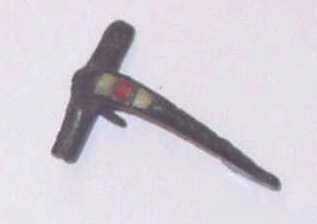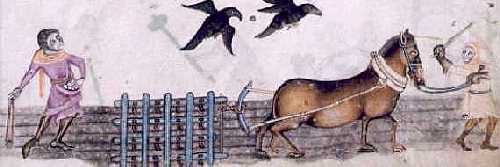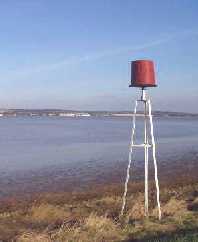|
Whitton North
Lincolnshire
notes on the history of a village.
|
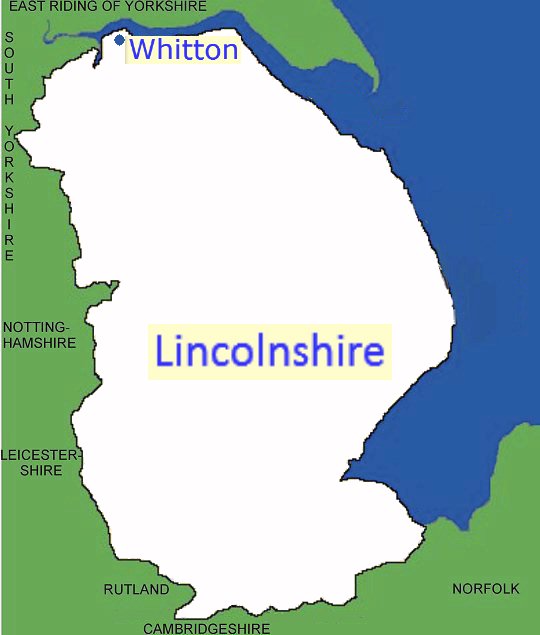
|
48
AD In the Beginning....
|
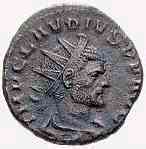
Coin of
Claudius Gothicus
|
The
village of
Whitton, by the river Humber, was probably several centuries old by the
time it was recorded in the Domesday survey of 1086.
After Claudius’ invasion of Britain in 43 AD , the Roman IXth Legion
advanced north and reached the south bank of the Humber by 48 AD. Here
the Romans halted to consolidate their rule in the south, before
crossing the Humber northwards in 71 AD to complete the conquest.
Could Whitton have originated at this time, first as a military camp
and then later as a Roman villa on the Cliff Top with its temple a few
yards to the east, where the Church now stands ? Perhaps Whitton was a
landing stage on the south bank for the Roman fort of Petuaria
Parisorum at Brough across the river. Roman coins of
Claudius
Gothicus (268-270 AD) and Constantine 1 (309-337AD) have been found in
the fields.
Nikolaus Pevsner suggests ( in The Buildings of England:
Lincolnshire [1989], p.797) that the church tower 're-uses
massive
blocks of Roman stone', but these blocks of millstone grit which are to
be found in several local churches (e.g. neighbouring Winteringham) may
have been sailed down the Ouse and the Humber from York where Roman
buildings were being dismantled or may even have come from some sort of
triumphal arch or structure (perhaps like the Arch of Constantine),
which might have stood at the end of Ermine Street... |
In
1998 researchers
from Hull University discovered major concentrations of Roman finds to
the south of Ings Lane, near to the five metre contour line.
Rectangular
crop marks are clearly seen at certain times of the year.
Perhaps, before the river was embanked, the Humber flooded the low
lying land immediately to the east of Whitton and a Roman settlement
stood on a forgotten ‘shore’ where now winter wheat grows.... |
Roman
enamelled pin found at Whitton |
410
AD By 410
the last remaining soldiers had left Britain to defend Rome and Whitton
ceased to be part of the Roman Empire..... As the local administration
collapsed the inhabitants probably returned to the countryside, and
reverted to the self-sufficient lifestyle of the pre-Roman era..... But
soon there were more visitors to Whitton, as from about ...
450 AD Anglo-Saxon settlers began to arrive
in the
Humber estuary. (right) (Evidence of Anglo-Saxon burial practices,
including oak coffins with elaborate metal fittings has recently been
discovered in a Chapel Lane garden.) The early inhabitants of Whitton
will have fed themselves by growing familiar crops like wheat, oats,
barley, rye, peas and beans, supplemented by, fishing, hunting and wild
fowling. Wild animals for food could have been got from a variety of
places in the village, including the marsh and shore below the
settlement as well as the woodland, and the river and estuary waters of
the Humber. Whitton's diet might even have included dolphin, porpoise
and whale - bones of these have been dug up at nearby Flixborough. They
could have been obtained directly by hunting in the river, or from
beaching sites along the shore.
|
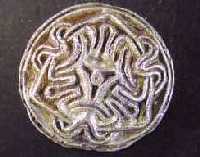
|
And
sitting, as
it does, on a promontory over looking the broad River Humber, the
villagers must have had a very good view of the Danish invading fleet
which sailed by in the year 872 AD on its way to
winter
at Torksey.
Left: A woman's
silver-gilt Viking brooch of
the late 10th or 11th century found in Whitton in 2000.
Diameter
26mm |
|
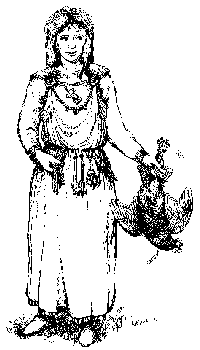
Click for photos of the archaeological
'dig' in Whitton
in 2002
|
Whatever
the truth, all is silence
until......
1086
Domesday Book Witenai
'Land of Henry de Ferreres. Manor - In Witenai Seubar
had twelve
carucates of taxable land. There is land for 8 ploughs. Saswalo,
Henry's man has 2 ploughs. Ten villagers and four smallholders and
thirty freemen have five ploughs. There is 300
acres of
meadow. In King Edward's time it was worth £ 10, now
£ 7.
Taxed £ 3.'
|
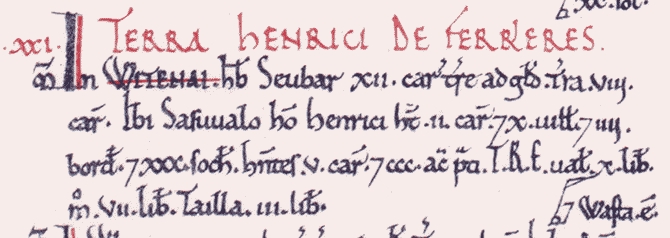
|
Notes:
There is no mention
of a church or priest.
The
very high proportion of freemen (30 out of 44 heads of housholds) may
indicate that Whitton was a
settlement of Danes amongst the people that they had conquered.
Remarkably, 44 households implies a total population of around 180 for
the village, which is very similar to today's figure.
|
Henry
de
Ferreres was the Lord of Longueville in Normandy; He had a
castle
at
Tutbury, Staffs and was a Domesday commissioner. He had large holdings
in Derby and also in 14 other counties. He was an ancestor of the earls
of Derby. Saswalo seems to have held tenancies of Henry de Ferreres at
Hough, Hatton and Etwall (DBY), Titchmarsh (NTH) as well as here at
Whitton.
The 'worth' of a manor was an estimate of the money its lord would
receive annually from his peasants.
A ferry is not
mentioned at Whitton, although Domesday Book
mentions ferries, on the Humber, at Winteringham, Barton and South
Ferriby.
|
1086
Whitton = 'Hwita's
island of land'
by the
River Humber ?
According to
Cameron the
place
name is an Old
English (OE) masculine
personal name,(genitive -n) + OE ēg, hence 'Hwita's
island of land', but Ekwall thought the name meant ‘White Island’
perhaps
assuming that
the ground was chalky. Although bits of oolitic limestone are seen as
scatter
in the fields of Whitton, they are unlikely to have struck any colonist
as
sufficiently white to have influenced the name.
Gelling pointed out that the settlement is situated on an
obvious ēg,
i.e. an 'island' of dry
land,
projecting into the
Humber estuary, and surrounded on east and west by former marshy ground.
Sources: E .Ekwall,
The Concise Oxford Dictionary of English Place-names (Oxford,
1960), p.515; K.
Cameron (ed.), Place
Names of Lincolnshire: Part 6
(Nottm, 2001), pp.118-19;
M. Gelling, Place-Names in the Landscape (1984),
pp.34-5
| By
about 1115
(The Lindsey Survey) the village is called Witena,
and in...
1179
the place is referred
to as Wihitene in the Charter Rolls. By the year
....
1276
Rotuli hundredorum
gives Whiten.
|
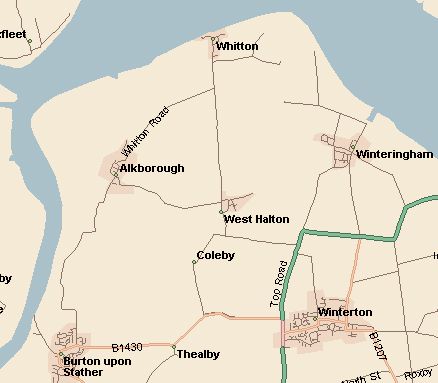
|
1197-1213
Whitton church seems
to have been dedicated, some time between these years, by
Robert,
Bishop of Bangor. According to a note in the Welbeck
Abbey chartulary,
the Bishop consecrated three altars on the 27 April (no year given);
the
high altar in honour of St. John Baptist, an altar in the body of the
church (in corpore ecclesie) in honour of the
Blessed Mary, the
Mother of God, and an altar in the north aisle in honour of St. Mary
Magdalene.
Source: W.
Page
(ed.),
Victoria County History of Nottingham: Volume 2 (1910), pp.
129-38.
Notes:
Although some have ascribed Saxon features to the church tower, there
seems no part of the church which dates from that time. Robert
de
Shrewsbury was Bishop of
Bangor from 1197 to 1212/13. This is the only reference found
to
a
north
aisle.
1278
Bishop of Lincoln's Visitation to
Wyten
Wyten - Abbas de Welbeck habet in proprios usus. Robertus vicarius
sexagenarius ; institutus presbiter xij annis elapsis.
Whitton - Owned by the Abbot of Welbeck (in
Nottinghamshire).
Robert the vicar is about 60 years old and was appointed parish priest
12 years ago.
Source:
C.W.Foster (ed.), Diocesis Lincolniensis: rotuli
Ricardi
Gravesend, Parts 1258-1279 (Lincoln
Record Society, 1925)
1332
Whitton's Lay Subsidy
| William
sutor |
6s
8d |
| John
de Hatcheby |
2s
8d |
| John
Palmer |
1s
8d |
| Ralph
filius
Walteri |
8d |
| John
Raulyn |
3s |
| Margery
de
Clecham |
1s |
| Thomas
le
Tayllour |
3s |
| Henry
de Houden |
5s
4d |
| Geoffrey
Raulyn |
1s |
| Robert
Marrays |
1s
4d |
| Peter
Fouler |
4s |
| John
Bygot |
1s |
| John
Halyman jnr |
1s |
| William
de
Haycheby |
6s
8d |
| Thomas
Felice |
8d |
| John
filius
Sibille |
5s |
| William
Abby |
4s |
| John
Kyng |
2s
6d |
| Thomas
Saunfayle |
2s |
| Margery
Alcok |
4s |
| Alice
Euerard |
8d |
| Robert
filius
Galfridi |
1s |
| Sybil
uxor
Walteri |
2s |
| Simon
Bygot |
1s |
| John
Halyman |
1s |
| Total
£ 3 9s 6d |
|
|
The Lay
Subsidy of
1332 gives us a first look at the names of some actual Whitton people.
It is a list of those people who had to pay a proportion of the value
of their property in tax, in the time of King
Edward
III.
From
the late 1100s until 1334,
personal property taxes (levies based on moveable goods, rather than
land ) were determined and collected by local assessors who kept
detailed accounts to present to the Exchequer. The lay subsidy rolls of
1332 were enacted by Parliament on 9 Sep 1332 in order to fund "great
and arduous affairs in Ireland and elsewhere."
There were exemptions which included equipment necessary to pursue
one's occupation, ranging from a knight's armour to a merchant's
capital. The very poorest did not pay anything and it will be seen from
the table that nobody in Whitton seems to have been assessed for less
than eight pence.
Notes
'filius'
means son, 'uxor'
means wife and 'sutor' may
mean that the man was
a shoe maker.
It
is interesting to see the
surname 'Bygot' in the list as this family name was still in Whitton at
the time of the 1642 Protestation Return. The name might be derived
from an oath..
A number of surnames apparently derive from place names - 'Hatcheby'
and 'Haycheby' from Haceby. 'Clecham' might be Cleatham near Kirton in
Lindsey. 'Houden' is Howden in Yorkshire.
'Halyman' perhaps originally literally a holy man and no doubt used
sarcastically to mean a hypocrite. 'Felice' from a nickname meaning
'happy'. 'Marrays' meaning a marsh, or from the French town of Marais
in Calvados.
|
1342
French spies in Whitton ? On
March 20th 1342 King Edward III issued, 'An Order to the bailiffs of
Whitene to make diligent scrutiny of all those who come to Whitene for
a passage……..as the king has learned that there are several spies upon
his secrets in England, and others who send letters to France and
elsewhere to forewarn the King's enemies.'
Source: Calendar of Close Rolls 1341-43,
p.485. This
Order was
sent to all ports in the kingdom.
1349
The Black Death By the
middle of the 14th century Lincolnshire was one of the richest and most
populous parts of England, but a series of bad harvests had caused
famine and increased the chances of plague. The Black Death of 1349 was
the most devastating of a long series of these scourges. Because there
are no records of burials in Whitton churchyard from that time, it is
not known how many Whitton people perished in the Black Death, but it
may have been from a third to a half of the village.
This was the time that some villages in North Lincolnshire disappeared
completely - Haytheby just west of West
Halton, Sawcliffe, High Risby and Low
Risby north
of Scunthorpe may have disappeared at this time.
1400
The
third Church Bell 'The 3rd bell is thought to have been
brought
from Welton
on the other side of the Humber and that tradition is confirmed by the
fact that there is still in that Church, a bell precisely similar to
this in the lettering: +MARIA MATER DEI EST NOMEN
MEUM+.
This inscription at Whitton presents the peculiarity of two crosses
close together where the beginning and end of the inscription approach
each other.' - Rev J.T. Fowler, 1 Aug 1845
Notes : This bell is thought to date from
about the
year 1400 and may have been cast in York by John Potter. The Latin means 'My
name is Mary the mother of God'. The two other bells bear the
inscriptions : 'Daniel Hedderly made me in 1742' and 'John Walker C.W.
1742' and are 24 inches and 25 3/4 inches in diameter respectively.
Daniel Hedderly was born
in Hanbury, Staffs
was a bellfounder in Lincoln and died there in 1766.
The three bells hang in a wooden frame from
wooden headstocks
on plain bearings. At the moment they are judged
to be in a
dangerous condition and only one bell is rung. Click
to see the church bells |
| The
'Passing-Bell Within living memory the
'Passing-Bell' was
rung to announce the death of a Whitton parishioner. The number of
times that the bell chimed would indicate to the village who had died -
three chimes for a child, six for a woman and nine for a man, then,
after a break of a few seconds, the bell would ring again and Whitton
would know the age of the deceased from the number of chimes which
followed..... |
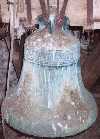 |
1519
July. Report of an inspection by
the Diocese of Stow
- Vicarius ibidem est canonicus de Welbeck. Exhibet omnia.
Cimiterium non est bene clausum. Vicaria dimittitur laico, vicarius
tamen
residet et bene facit. Cancellus est defectiuus.
Source:
A.H.Thompson,(ed.), Visitations
in
the Diocese of Lincoln, 1517-1531, Lincoln Record Soc.,
vol.33
(1947), p.94
Notes:
The report,
in medieval Latin, seems to say that
the vicar was a canon from Welbeck Priory in Notts, who had succeeded a
lay member of the order; he lived in Whitton and was doing a good job;
that the churchyard was not properly enclosed and that the chancel was
substandard in some way.
The Abbot and Convent of Welbeck were then proprietors of the village,
but were expelled from Welbeck Abbey in 1539 and must have lost their
lands in Whitton
at the
same time.
1546
'Whitton Registers commence
in 1546, but have been for a great many years in such an unhappy
condition that it would be well, if anyone having the time and ability
to copy them would do so, before they get further perished. '- Parish
Magazine in 1887
The first few, readable, marriages from the Whitton register are shown
below - there were still members of the Waddingham family in the
village some 400 years later:
1546
..., Robert and
Elzabeth SAWER
1562 BEALE, George and Johan HAMMILTON
1564 SOUTH, Henry and Margaret WADINGHAM
1566 GLEFEILD, John and Margaret MOORE
1567 STAYNTON, John and Elzabeth MOTE
1567 BEALE, George and Margery RIDLEY
1567 DAVYS, Stephen and Elzabeth FORMAN
1568 WESTOBYE, Robert and Elzabeth RAMSEY
1569 HARRYSON, Jonat and Johan ...
1570 PELTER, Henry and Mary ENGLE
1571 LUDDINGTON, Robert and Alyson LAINGLEY |
1572
WADDINGHAM, and
Margaret W.
1572 FENWICKE, and Eme WRIGHT
1573 JOHNSTON, William and ... DANYELL
1574 COOKE, and Elzabeth SLATOR
1574 COOKE, William and Isable CROSBYE
1575 MANNERS, Anthonye and Margaret STAINFOURTH
1575 ROBINSON, Cycilye and Thomas ...
1575 THOMPSON, William and Janie BREWER
1576 JAMES, Robert and Alyson BIGOT
1576 RAMSEY, Thomas and Ellin BENSON |
The
registers are supposed to contain the
names of as many as 1,800 men and women that have been buried in
Whitton churchyard. How many then since the foundation of the church,
3,000 ? The level of the churchyard, above the surrounding
land,
makes such a large number seem plausible.
The registers are now held at the Lincolnshire Archives
Office.
|
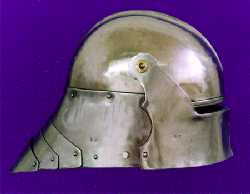
A 'sallytt' or sallet
was a light
armoured headpiece.
|
1558
The last
Catholic priest of Whitton ?
Stephen Thomson clericus
died
in December 1558 and his probate inventory, besides mentioning the
usual 'fetherbedes', 'sylver spones' and 'puter pottes', lists a
'sallytt' and a 'halberd'.
This priest had lived through the years of Henry VIII's Reformation and
the reigns of his children, the boy king Edward VI, the Catholic
leaning Mary and he died only days into Queen Elizabeth's rule. Perhaps
he was the last Catholic priest in Whitton and he had needed those
items of self-defence during the turbulent times which he had seen..... |
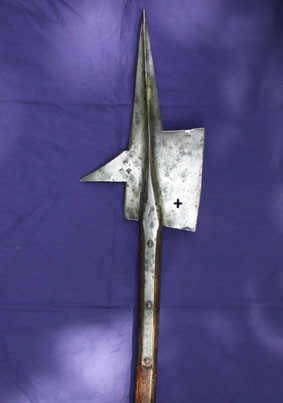
A halberd
was a two-handed pole weapon.
|
1578
10th Jan George Waude
(also called Woade or Wade) is ordained priest of Whitton by the Bishop
of Lincoln. In 1598 he was described as being not a graduate, or a
preacher, but of good behaviour, married, resident in Whitton and
'hospitable'. In 1602 he says the number of villagers taking communion
is one hundred and the following year the church is said to be 'in
reasonable good case, both for repayre and decencie in the keapinge'.
He died in 1607 and was succeeded by William Walshe.
1642
Protestation Return for
Whitton. The protestation
return was a list
of males over 18 in the village, who professed to be protestants,
which seems to have been everybody... 46 different surnames. 58 names
in total.
An estimate of Whitton's population may be worked out by doubling (to
include women) and adding an estimated 40% to account for those under
18 - which gives 162; not too different from today's figure.
Taken on
Saturday 5th and Monday 7th
March.
'None of our towne above the aige of eightene years have refused.'
Anderson,
John
Bainton, Thomas
Beale, George, sen.
Beck, Robert
Bell, George
Bell, Peter
Bell, William
Bishopp, Henry
Browne, Robert
Browne, George
Browne,Francis , Constable
Bygott, Richard
Bygott, Richard
Bygott, Michael
Bygott, John
Bygott, William
Bygot, George
Easton, William
Etherington, James
|
Furley,
John
Garthom, Richard
Grant, Thomas
Hailes, John
Harland, Thomas,Churchwarden
Harrison, Robert
Hart, Robert
Helroys, Gervas Esq *
Herron, John
Hood, George
Lindley, Robert
Maison, Stephen
Martin, George
Newbie, Richard
Porte, George
Post, Abraham
Potton, William
Ramsey, George
Ramsey, William
Ridley, George |
Robinson,
William
Settles, Richard
Sharpe, George
Simpson, Christopher
Snickler, Edward
Snowden, William
Storme, Anthony
Thomas, Nicholas
Thornton, George, jun, Churchwarden
Thornton, George, sen.
Tingle, Hugh, Minister
Tingle, Simon
Townsend, John
Walker, John, Overseer
Waller, William
Welche, Timothy
Whittington, George
Williams, John
Winter, John |
| *
Perhaps a son of
Sir Gervase Elwes or Helwys, (baptised 1561, hanged 1615), court
official
and convicted accessory to the murder of Sir
Thomas
Overbury (1581-1613). The surname
is variously spelled Helwysse, Helvis, Helwys and Elwaies at this time.
A Jane Elwyse was baptised in Whitton on 30th Jan 1618. |
1653
From the Churchwardens' Accounts
Collected in
the p_ishe
Church of
Whitton the 21st day
of August 1653 for ye inhabitants of Marlborough, ye some of xiiij s
viij d and payd into ye hands of Matt Gere chosen Constable. Jo
Dugdaile Minister ibid.
Note
: The 14/8d ( 73p) was
collected for the people of
Marlborough, Wiltshire as a great fire had destroyed the centre of that
town on 28th April 1653.
1660
From Whitton's Parish Register
'John, son
of Thomas Norton baptised September 15th; the said
John was buried the same day.'
1664 'Feb 28th burialle Sir Edmund
Skerne, Knight'.
Note: Perhaps this was the same Sir Edmund of
Bonby,
knighted in 1619, whose family ownd lands in Alkborough and Burton
Stather.
1667
A Whitton
Trade Token. From the late 1640s to the late 1670s, during
the
turbulent period of the Commonwealth
and the first part of the reign of
Charles II, there was a shortage of small change in circulation.
Traders produced trade tokens, which were privately produced
substitutes for official coins. Seen here (right ) is the obverse of a
half penny one used in Whitton. It is 19.5mm in diameter.
Obverse : Clockwise round the rim from the top IN . WHITTON
.
1667 In the centre is an image of St George and the Dragon.
Reverse: GEORGE . BEALE and, in the centre HIS HALF
PENY
The prosperous Beale family were in Whitton for well over 100 years
-see 1546 and 1642, above. |
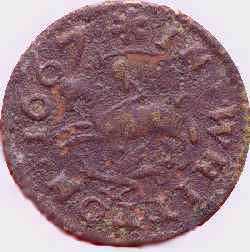
Courtesy: North Lincolnshire Museum
|
George
Beale born 1624,
married Elizabeth Thornton in 1644 and died in Whitton in 1684. In his
will he left £ 5 to the poor of the village as well as £ 5 to
Alkborough's poor and 20/- to the poor of West Halton. His Probate
Inventory values his goods at £ 587-14-6 (perhaps £ 75 thousand, today)
and
shows that he owned many sheep and cattle both in Whitton and
Alkborough and also, one sixteenth part of a boat, 'a vessell called
hopewell' worth £ 22. (see below)

It is interesting to speculate on the trade of George Beale in Whitton.
Because of the image on the token, perhaps he was an innkeeper at the
sign of the 'George and Dragon'. |
1676
The Compton Census was an
ecclesiastical census taken in 1676 and named after Henry
Compton, the Bishop of London. The adults (i.e. people over
the age
of 16) of
each parish were recorded
as either Conformists, Papists, or Non-conformists .
Whitton - 56 Conformists; 0 Papists; 3 Non-conformists, and for
interest :
West Halton - 138 Conformists; 0 Papists; 4 Non-conformists
Alkborough 161 - Conformists; 0 Papists; 0 Non-conformists
Historians regard this census as a valuable source for estimating the
population, but if one accepts their current idea that the proportion
of the population over 16 in the parish was between 60% and 70%, a
simple calculation gives the total population of Whitton as a
surprisingly low 91, of West Halton 218 and of
Alkborough 248.
Perhaps Whitton's low population was the result of a series of
epidemics, which can be inferred from parish register entries. Between
1660 and 1679, there were 25 more deaths than births recorded. There
had been as many as 100 communicants in 1603.
1678
A manuscript in the Guildhall
Library in London lists Whitton parish as contributing towards the
rebuilding of St Paul's Cathedral, which had been burnt down in 1666.
1679
The Plague in
Whitton ?
Four or five names per year, appear in the Whitton
Burial
Registers around this time, but in the five weeks between 21st November
and 30th December 1679 there are thirteen deaths recorded - a very
large number for such a small village.
The years 1657-59, 1670 and 1678-80 were similarly morbid and in each
of these periods about one sixth of Whitton's population died .
This might have been the last gasp of bubonic plague which had brought
death on a massive scale from 1348 to about 1679 and which then
mysteriously disappeared, but other diseases prevalent in England at
this period were smallpox, dysentery, measles, cholera and 'ague'. |
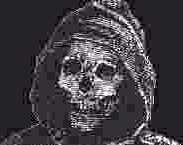 |
| Neighbouring
Winteringham had a large number of deaths in 1679/80 of which many were
attributed to ague, the malarial like 'fen-fever'. |
1686
The Quakers in Whitton Efforts
were made by the Society of Friends to ensure that members married
'within the Truth' i.e.
other
members.
12 Nov 1686. 'At the house of Thomas Markham in Brigge.... it was
ordered by the meeting that Thomas Wressle of Winteringham and Robert
Wilkinson of the same, goe and speak to Margaret Hood of Whitton,
Widdow and admonish her to keep to the Truth and to keep clear of
letting out her affections towards marriage that soe Faith and Friends
may not suffer by such disorderly proclivities and bring in her answer
to the next monthly meeting.'
Happily, this reprimand was ineffective as the Whitton Register two
weeks later shows:
'Nov 25 Thomas Walker & Margaritt Hood, married'.
It would not be long before Methodism began to be the choice of the
dissenters of Whitton...
1687
The
Old Manor House used to have a piece of old oak embedded into
it,
marked
'PEM 1687.
'The Manor House is at present (1940) divided into
two
cottages, the one on the south side has had a piece built onto it .
This was done by the present owner Mr Maurice Bray in 1921. The cottage
which forms the north side of the house was bought at the Whitton Sale (1919)
by Mr W Oxtoby' - (ks)
Note: Perhaps this house of 1687, with its
tumbled
gable and metal tie plate, replaced an earlier village Manor House
which stood on the Cliff to the west of the Church , see the entry for
1697 below. |
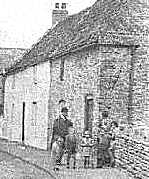 |
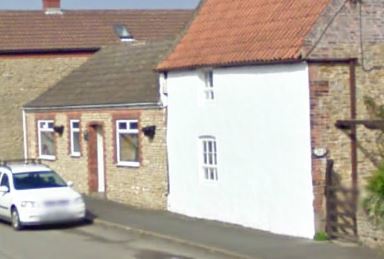 |
1696
From Whitton's Parish Register ' William
Pickergill, a stranger who was slain by a fall from
the Cliff, buried October 18th' - Francis Turpin, Vicar
1688-1699.
1697
An extract from the journal of
Abraham de la Pryme - the Curate of Broughton
29th May
"From thence ( Alkboro'
) I went to Whitten. The
town is but a little inconsiderate town, as most of these Lincolnshire
towns are. It is seated mighty advantageously, having the Humber
running close to it.
There is nothing worth seeing in the whole town.
The present lord of it, Mr Pleadwell, who lives in London,
got
it by marrying the daughter of Sir John Morton who was lord of it
before.
About 20 years ago there was part of a great hall standing on the west
side of the Church in a cloase where the Mortons lived, but now onely
part of the foundations appear.
The Church of this town is but mean and there is nothing worth seeing
in it .
When I first saw the town, it put into my mind a song that I had heard
of it , which ended at every verse thus:
|
'At
Whitten's town
end ,brave boys
At Whitten's town end .
At every door,
There sits a whore,
At Whitten's town end .' "
|
Source: A. de la Pryme, The diary of Abraham de la
Pryme, the
Yorkshire antiquary, Surtees Society, vol 54 (Durham,
1870),
p.139
Note :
'A line of tiles,
possibly a floor, was reported exposed in the cliff side and was
possibly associated with the Hall' - C.W. Phillips, Ordnance
Survey Site Index 1929.
1709
The Glebe terrier, an
inventory of church property, highlighted the continual problem of
estuarine erosion. It begins : "The Vicarage House consists of three
bays, two whereof are chamber'd with fir plank and timber, the third
bay used as a Barn, and no outhouses belonging to it. The Homestall
contains about one half rood of ground so near adjoining the River of
Humber that is to be feared that in less than an age it will be
swallowed by it, for the river has in the memory of man swallowed up
the ground upon which two or three cottages did stand near adjoining to
it. " (LIncs
Archives: Whitton PAR/3/1)
Note:
A rood is a quarter
of an acre.
1721
From the Whitton Parish Register. Childbirth was a dangerous
business as Rev. William Holgate noted
:
20 Feb;" baptised - George, son of George Cooper & Mary and
buried
- Mary, wife of George Cooper : same day."
1723
Extract from Whitton
Churchwarden's and Constables Accounts: 'Feb 28th. A
bargain made with Robert Fairweather for to repair the church leads and
windows - the steeple excepted - and for the present he is to have one
pound and a shilling and to find glass, lead and powder that is wanting
for the church. And for the futer (sic) to be
paid ten
shillings a year at every easter to keep it in repair in his lifetime
and to be allowed six pence a Day for every day's work at the said
Church. - Wittness our hands, Robert Langton, Thomas Hodson, Thomas
Willson, Robt Potter, Thomas Walker'
Note: the
mention of a
'steeple'.
1730
From the Whitton Parish Register.
31 March; baptised - Easter Wade,
daughter of John and
Mary Wade.
Note: Perhaps she had been born on Easter Day the
29th March,
two days before.
1756
Note
in one of the Whitton Church Registers." In the year one
thousand,
seven hundred and fifty-six our common was not stocked on May Day as
usual which fell on a Wednesday, but was kept till the Monday following
by reason of the very cold and wet season " - William Metcalfe (Vicar
of Whitton and Alkborough 1742-1765 ).
Note: This
suggests that pre-enclosure Whitton had a by-law allowing
common
rights of pasturage in the (Common) Marsh from 1st May until a later,
unnamed, date.
|
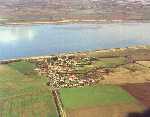
Click to see
Whitton from the air
|
1773
WHITTON ENCLOSURE ACT The
English countryside was transformed between 1760 and 1835 as the ridge
and furrow, open-field system of cultivation gave way to compact farms
and enclosed fields. Alkborough was the first in the area to be
enclosed in 1768 and Scunthorpe/Frodingham completed the area in 1834.
Most of Whitton was already the property of Thomas Goulton, the Lord of
the Manor, who was also lessee of the 'great tithes' under the Bishop
of Lincoln. The usual procedure for land enclosure was the presentation
of a petition to Parliament by persons locally interested - in this
case Thomas Goulton. On this petition, a Bill was introduced, which was
referred to a Committee, usually a Select Committee, after its Second
Reading. If the Report of this Committee was favourable, the Bill was
subsequently passed and Commissioners were sent to the parish concerned
to arbitrate between conflicting interests, and make an award.
'An Act for Dividing and Inclosing several Open Fields, Lands
and
Grounds, in the Parish of Whitton' - was passed in 1773. Two
Enclosure Commissioners were named in the Act, Edward Johnson of Hull
and William Jepson of Lincoln.
James Goulton-Constable noted in 1889 that -
'Some of the
parish had already been enclosed. The
old enclosed part consisted of all the houses, yards and gardens in the
village plus Whitton Ashes and the Low Plantation, and a number of
small fields immediately to the east of the village. Some of these
fields , together with the Low Plantation had the name “Whathams” '. (see
Appendix 2.f, below) . This old enclosing may have happened
in
Tudor or Stuart times to increase the amount of sheep pasture available
to the Lord of the Manor.
The measurement of the then enclosed part of the Parish is not given,
but that of the yet to be enclosed is given as about 1088 acres.'
1775
Whitton is transformed. Enclosure
was completed in March 1775 and the changes to the village that Messrs
Johnson and Jepson had drawn on their maps during the two years, are
substantially those features to be seen in Whitton's landscape today.
A principal road 1.3 km long south to the West Halton parish boundary
was constructed. It was 60 feet wide and separated the old Longlands
field in the east from the western Lammer field. This new road joined
with the road north out of West Halton, which had been laid out, two
years earlier, in 1773
when West Halton was enclosed . Edward Johnson had been also a
Commissioner
at the West Halton enclosure.
The other principal road of about 1km was constructed south-west from
the Whitton-West Halton road to the Alkborough parish boundary from
where, it continued across Alkborough's Sand field along the road made
in 1768 when that village was enclosed. This second principal road of
Whitton may have been drawn from the Alkborough boundary to a pond next
to the Whitton-West Halton road perhaps for the convenience of the new
owner, Mr Goulton. The pond subsequently silted up, but has been redug
in the last 40 years.
There were several new secondary roads ; Ings Lane, and the roads to
Marsh and Argons were made at this time. Drains were dug to improve the
drainage of this eastern area of the parish and the Enclosure Award
also mentions the construction of 'sea' banks and sluices.
The familiar fields of Whitton came into existence at this time, and
the new owners had to fence or hedge them with quickthorn by November
of the same year.
The
Table below,
shows who was awarded what acreages of land, and their shares of the
costs of Enclosure. The expenses incurred in fencing or hedging the new
fields were extra.
|
Land
Awarded at
Enclosure
|
Acres
Roods Perches
|
Share
of Cost
|
| a) Special
Allotments . |
|
£
s. d
|
| Vicar,
in lieu of Glebe and rights
of Common |
3
2 19
|
NIL
|
| Vicar,
in lieu of Tithes |
51
2 1
|
NIL
|
| Bishop
of Lincoln, in lieu of
Tithes |
150
2 0
|
NIL
|
| Surveyors
of the Highways |
0
2 0
|
NIL
|
| (b)
General Allotments |
|
|
| 1.
Thomas Goulton |
832
2 23
|
570.
18. 8
|
| 2.
Heirs of John Westoby |
17
2 31
|
13.
14 2
|
| 3.
John Wetherill |
3
0 3
|
1.
17. 5
|
| 4.
Ann Brown, widow |
2
2 12
|
1.
15. 0
|
| 5.
John Helm |
2
1 24
|
1.
15 3
|
| 6.
Mary Borringham, widow |
2
1 10
|
1.
17. 4
|
| 7.
Heirs of John Gawthorpe |
2
0 32
|
1
17.11
|
|
8.
John Scarborough
|
2
0 4
|
1
14. 7
|
Whitton
was changed for ever.
Although enclosure was necessary so that farming and food supply could
be revolutionised, it reduced the powers and rights of the ordinary
villagers of Whitton and had unfavourable social effects. Land
reallocation under the enclosure act was supposed to compensate those
losing their rights to common land but, in practice they lacked the
capital to utilise the land, and the smallholders could not live
adequately from their new plots and had to become agricultural
labourers; further, landless labourers received no compensation.
However both the power and the wealth of Thomas Goulton (1745-1826) of
Walcot Hall, and his successors, were greatly increased.
Note
: The last
remnant of ridge and furrow in Whitton can be seen in a pasture about
400 metres down, and to the south of, Ings Lane.
The field name 'Argons' may be the old word 'argins' or 'argines' which
means an embankment. (O.E.D Vol 1 ) cf.
'Agger' a mound or rampart formed by the earth excavated from a ditch.
The Whitton Enclosure Award (ref
LAO: Lindsey Award/88) can
be inspected at the Lincolnshire Archives
| 1775
Appearance of
hamlet of Bishopthorpe. 'It was under the sanction of
the
Enclosure Commissioners that the Bishop of Lincoln gave to Thomas
Goulton the old homestead belonging to the Rectory with the decayed
dwelling house, barns, stables situated in the village on the south
side of the church yard, in exchange for two acres of land in the Ings,
on condition that Thomas Goulton build a
new dwelling
house, barns and stables on some part of the land allocated to the
Bishop of Lincoln in the Ings. Thomas Goulton therefore, in fulfillment
of this condition, built the homestead known to this day as
Bishopthorpe'.(James Goulton-Constable) |
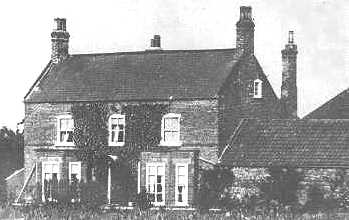
Bishopthorpe Farm
|
1781
Whitton Parish v Judith
Coulson Overseer of the Poor and Churchwarden, Richard
Langton
issued a bond 'to Thos. Coulson, yeoman late of Welton, Co.Yorks,
butcher to indemnify the Parish for the relief of ( his
daughter,
31 year old ) Judith Coulson and the children she may bear'.
The
following year a warrant was issued for the apprehension of Henry
Britten, the putative father of the bastard child of Judith Coulson.
Notes : The 'bond' was an agreement binding on
Thos. Coulson
and meant that he, rather than Whitton parish, would support Judith's
children.
Judith Coulson was baptised at Welton across the river on 3rd Jan
1750...
1790
17th August Dissenters'
Certificates Thomas Cousins and Sarah Sharp applied to the
Bishop of Lincoln for their own houses in Whitton
to be registered as
places of religious worship 'for the use of His Majesty's subjects
dissenting from the Church of England, now commonly called Methodists'.
The applications, which were granted, were signed by Thomas Cousins,
Sarah Cousins, John Walker, Ann Walker, George Epworth and Sarah Sharp.
Notes: These
villagers continued to
attend services in the church and a schism, with the established
Church, had yet to appear; see the 1799 church seating plan, q.v.
This was at a time when the founder of Methodism, John Wesley, was
still alive; he was to die on 2nd March 1791.
1794
The old
church before rebuilding
|

|
An
extraordinary drawing of old Whitton Church in 1794 by
John Claude
Nattes (c1765 - 1839), the draughtsman and water-colourist.
Only
the tower is recognisable - and that without its
familiar pitched roof. The nave appears to have a south aisle and porch
attached. The roof has a ladder resting on it near to gaps in the
slates. The last of four pinnacles totters precariously on the top of
the tower.
Source: LCCL, Banks Collection, IV, 273
|
1797/8 The
old
church is rebuilt
"1797
is spoken of as
being the year when the old Church was rebuilt - before this, in all
probability the tower had battlements or pinnacles. The two stone
pinnacles on the top of the Churchyard wall by the gate belonged to the
old Church. They were found under the chancel during the alterations in
1889." (ks)
Notes: But
the later date '1798' can be seen carved
into a stone of the outside south wall, above the vestry door.
The pinnacles are small pyramidal spires, apparently 'crocketed', that
is having knobs of stylised foliage supposedly like a shepherd's crook.
See
the criticisms of the new church, and its benefactor
Thomas
Goulton,
by the Venerable Stonehouse under 1850,
below.
(right
) The 'crocketed' pinnacles by the church gate.
|
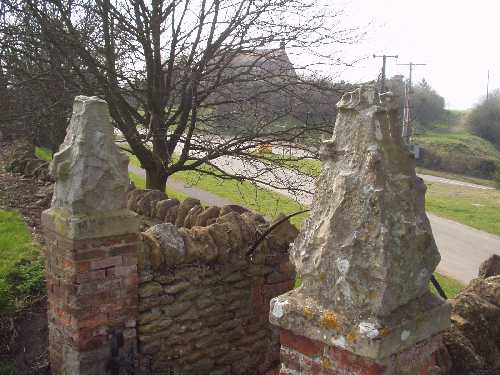 |
1798
Wednesday 7th
November. 'A sloop, called the Hull Packet, Thos.
Auckland,
master, laden with groceries, etc., bound from Hull for Gainsbro', was
lost on Whitton Sand. The people on board, consisting of the
master, his wife and four children, and one man, were providentially
saved. Mrs Auckland, with an infant in her arms, was about
two
minutes under water, and on rising to the surface, she luckily put two
of her fingers into the bung hole of an empty Burton Ale cask, which
was the means of both being preserved.'
Source: Leed
Intelligencer,
12 Nov 1798; Newcastle
Courant,
17 Nov 1798
1799
Saturday 3rd August. On that
day it was found necessary to have a meeting to allocate pews 'by Lot'
in the new smaller church, amongst the various social classes which
then existed in the village. The seating plan produced that day gives
the surnames of the farmers, freeholders and cottagers with their pew
numbers.
Pews were also allotted to men servants (front row), female servants
(back row right) and widows and single Housekeepers (back row left.).
Perhaps the men servants had been causing trouble in church.
Click to see the 1799 Seating Plan for Whitton Church
1802 Poaching
'Whereas the game
within the manors
of Whitton, Halton, Aukburrow, Walcot and Colby. hath been destroyed by
Poachers of various Desciptions;
notice is hereby given, That whoever is found trespassing
there
in future will be prosecuted, Walcot near Brigg, Sept 6 1802' - Stamford Mercury ,
Friday 17 Sept
1802
Notes:
An advertisement presumably placed on behalf of Thomas Goulton. The
incidence of poaching tended to increase, after estates and commons
were removed from public access by enclosure. By early 1803 a list of
authorised gamekeepers had been published in the press; John Walker,
yeoman of Whitton was appointed, by Mr Goulton, for Whitton
and
Alkborough. Stamford
Mercury, Friday 14 January 1803
1803
The North Lincolnshire Legion was a 3,000 men
volunteer force raised at a public meeting in Brigg, by Lord
Yarborough, on
Saturday 17 Sept 1803, in response to Napoleon’s
planned invasion of the U.K..
The Legion, one of a number raised in the county, had its expenses
defrayed by public subscriptions.
In
November 1803, West Halton contributed nineteen guineas, Alkborough
twenty-five and Whitton
ten;
| Rev
William
Cookson |
£ 2-12-6 |
| Samuel
Butter |
£ 2-2-0 |
Joseph
Sharp
|
£ 2-2-0
|
| John
Spilman |
£ 0-10-6 |
| Ann
Cousins |
£ 1-1-0 |
Richard
Langton
|
£ 1-1-0 |
Sundry
|
£ 1-1-0
|
The invasion did not happen and the
Legion was
disbanded in 1813
Source: Stamford
Mercury,
Friday
18 Nov 1803
1804
The 'Plum' The
poet Henry
Kirke White while staying at Winteringham vicarage, walked
to Whitton and noted the petrifying spring which bubbles from a gladed
dell close by the Humber and which is called by the villagers, the
'Plum'. He wrote of the spring, in his dog Latin, 'Muschum,
conchas
et fragiliones ramos arborum in lapidem transmutans' which
seems
to mean 'Moss, shells and twigs are turned to stone ' .
This feature is not shown on the 1775 enclosure map and may have been
dug soon after this date as a source of gravel and building materials
to replace the existing gravel pit of that time, which was at the south
end of the village near to what is now the entrance to Mill Field Lane.
Radiated fossils called astroites or car-stones are searched for in the
'Plum' and on the Cliff above and local people used to call them
'kestles and postles' (which sounded like 'Christ and His Apostles' to
Abraham De La Pryme ). More recently the search is called 'starring and
fossiling'. |
The
tops of the trees
in the 'Plum' can be seen in the photo accompanying the note for 1858.
Notes: Kirke White (1785-1806) is
supposed to have
penned the
lines which start ' Oft in danger, oft in woe'
after crossing
the Humber in a ferry from Whitton.
The word 'Plum' may have originated from one of two dialect uses of the
word. It can mean 'a deep pool in a river' or alternatively 'soft
easily worked rock'. (O.E.D Vol 7) |
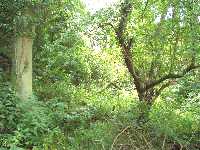
The 'Plum' in high
summer.
|
1814
18th October. Burial of '
Hannah the daughter of John and Elizabeth Gell who accidentally starved
to death by wandering from her parents into the fields, aged 2 ' - Rev.
John Wilson.
Note: Here 'starved' has the local dialect
meaning of 'cold'
.
1818
19th June Independent
Methodists . On this day application was made to the Bishop
of
Lincoln for a Dissenters' Certificate to enable the 'house or
appartments of John Westoby' to be used by 'His Majesty's subjects
dissenting from the Church of England commonly called Independents'
as a place of religious
worship. The application
was signed by 'The Minester (sic) Mr Plumstead,
Joseph
Dinsdale, John Westoby, William Smith and Edward Cambell'.
Note: The Independents seem to have been founded
by a
Warrington chairmaker called Peter Phillips around 1806 and a Quaker
plainness of speech and dress was apparently evident in their manner.
1818 24th
July The Revd
William Cookson,
who had been vicar for forty-five years since February
1773, died on
the 24 July. A memorial stone was fixed on the north wall of the
chancel to commemorate his ministry and, when the church was
rebuilt in 1893, (q.v.)
that stone was laid on its back in the churchyard, close to the
church’s north wall. It is now difficult to
decipher, but
reads in part:
Whate'er I did believe,
whate'er I taught,
Whate'er He did for me, who mankind bought,
In faith, in life, in word, in deed, in thought,
Resurgam
of them all is the full draught,
Whate'er is preach'd—and is not this—is nought,
Who preaches this, receive him as ye ought;
Reader learn well, but this short text from me,
Though I be dead, yet still, I preach to
thee!
The
Governance of Whitton The
affairs of the village were under the control of the Vestry that is, in
theory, all the village ratepayers meeting once a year in the Church
vestry at Easter to review the accounts and elect parish officials, but
in fact the work was done by just a few unpaid volunteers who were
answerable to the Justices of the Peace and the Chief Constable. There
should have been six men chosen - two Overseers, Churchwardens and
Constables but in practice, over very many years, Whitton was run by
less than this, as one or more served in two capacities. For example in
the year....
1819 March 30th. 'John Spilman and John Langton
gave up their
accounts and their :
| Imbursements
wherein |
£ 179-04-0
|
| Disbursements
wherein |
£ 177-14-7
|
|
Into
Purse
|
£ 1-09-5
|
'At the
same time Joseph Sharp and Thomas
England chosen Overseers of the Poor of the parish of Whitton and John
Spilman chosen Constable and Churchwarden for the ensuing year by us
whose names are under writen
Tho Butters Thos Walker John Westoby John Laming'
Notes:
The 'imbursements' were monies raised by levies on the occupiers of
property. The cash was spent on Whitton's widows, orphans and aged.
These accounts continue until 1834 when The Poor
Law Amendment Act replaced the parish Overseers with a
national
system for dealing with
poverty and its relief, based around the Union workhouse at ( in
Whitton's case), the Workhouse on Union Road (now St. Peter's Road) in
Brigg. The site later became Glanford Hospital and was demolished in
the 1980s.
1824
Whitton from an
engraving of 1824, surveyed
between 1819 and 1822.
The Windmill is clearly seen just to the left of centre in Mill Field
Close.
Willwick Hill Plantation is below it, its shape very similar to that of
today. A row of trees, (scotch firs ?) greets the traveller at the top
of the hill as he crosses into Alkborough parish,bottom left.
Bishopthorpe cottages on the West Halton road have yet to appear.
The pier and the road to it are not yet built.
Ings Lane and the road to the Marsh are seen in 1824, but a
thoroughfare north of Ings Lane and parallel to it exists now only as a
footpath - see the
photos of Whitton from the air..
The population in 1821 was 212 (in 49 houses) , which is more than
today's figure of about 180 |
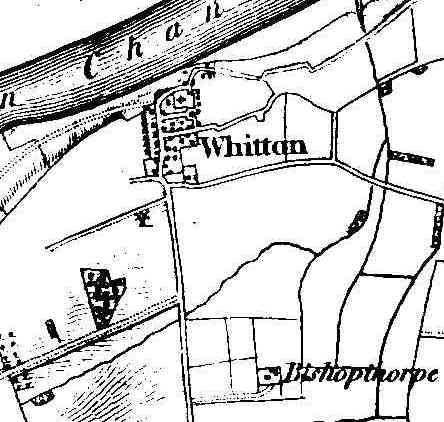
|
1824
18th June. Burial of Thomas
Wade, son of Wm. and Elizabeth Wade who was accidentally killed by a
cart wheel running over his neck. He was seven.
1826
Thomas Goulton (1745-1826),
owner of most of Whitton (and Walcot) died and the estates passed to
his nephew, Marmaduke Constable. Marmaduke was the son of Thomas
Goulton's sister Sarah and the Rev. Thomas Constable of Sigglesthorne
and Wassand, E. Riding Yorkshire.
1831
The census recorded 245
people - 134 males and 111 females in 54 houses. However the Land Tax
Assessment for 1831, lists only 41 tax paying properties - perhaps 13
families were either sharing houses or lived in properties valued at
under 20s. per year and officially exempted from paying tax.
Four of the villagers, the widow Elizabeth Langton, Driffield Legard,
John Everatt (at Bishopthorpe ) and John Spilman together farmed, as
tenants, a total of 70% of the taxable value of Whitton.
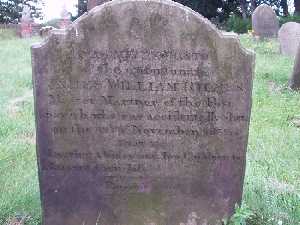 |
SACREE
MOMENTO
of the unfortunate
JAMES WILLIAM RICHES
Master Mariner of the Post
Ipswich who was accidentally shot
on the 19th of November 1832
: AETAT 33:
Leaving a Widow and Two Children to
lament their loss.
Remember me!
|
1832
According to the Cambridge
Chronicle and Journal of
30 November 1832, he was 'sailing in a small boat on the
river
Trent with a friend, when a gun which they had with them, went off and
the contents lodging in Mr Riches' side, he died two hours afterwards.'
|
1837
The violent end of Alice Dinsdale
of Whitton
Wednesday 7th June at 6am and
Whitton
shop-keeper
Alice
Dinsdale was waiting on board the Hull to Gainsborough steam packet,
the Union,
for it to leave
on the short journey from the Humber Dock Basin at Hull to Whitton. She had just two minutes to
live.
As the Union
cast off there was a rumbling and its boiler blew up with a tremendous
explosion, throwing large bits of metal 80 ft into the air and raining
corpses
onto, and through, the roofs of Minerva Terrace alongside the dock. In
that
instant thirteen passengers and crew died . Some bodies were never
found, but
Alice Dinsdale’s was retrieved from a neighbouring steam packet, the Don, 'and presented a spectacle too
horrid to attempt to
describe.' Alice was interred in Whitton churchyard and a piece of
doggerel on her gravestone reads :
'Stop
my friend and view my stone, Consider well where I have gone.
Prepare yourselves make no delay, For in a moment I was call'd away.'
Note:
Alice Hobson was born
in Frodingham in 1795 and was married in Winterton, in 1818, to Whitton
farmer Joseph Dinsdale . ( See list in 1842, below).
Source:
Hull Packet , Friday,
9
June 9,
1837;
Morning
Chronicle
(London) Monday, 12 June , 1837..
1842
Whitton, an extract from White's 'Gazetteer
and Directory of Lincolnshire'
Whitton, a village and ferry on the Humber, about 3 miles
below
Trent falls, and 9 miles W. of Barton, has in its parish 217 souls and
1240a. 1r. 15p. of land. Marmaduke Constable, Esq., owns nearly all the
soil, and is impropriator and lord of the manor, which is parcel of the
Duchy of Lancaster. The church (St. John The Baptist,) was
rebuilt many years ago, when its fine Norman doorway was destroyed, but
the ancient font is still preserved. The vicarage valued in
K.B.
£ 6. 10s. was augmented with £ 200 of Q.A.B. in 1767, and has long been
united with that of Aukborough. At the enclosure, about 70
years
ago, land was allotted in lieu of tithes. Opposite Whitton,
there, is in the Humber, a bed of silt, called Whitton sands, more than
a mile broad, and two miles in length, which is left bare at low water,
and upon which steamers and other vessels are often left aground until
the return of the tide, and in stormy weather sometimes
wrecked.
The ferry boat here takes passengers to and from the steam packets, or
carries them across the river to Brough, or Weighton Lock. In
the
gravel pit here, a very remarkable dip of the strata is exposed,
exhibiting, among the boulder stones, ammonites, gryphites, and other
fossils and shells, similar to those in the debris on the shore, where
many conglomerate masses have fallen from the cliff; near the summit of
which a petrifying steam comes from an incrusted rock. The
Ferry
House is at Brough, on the Yorkshire side of the Humber.
GREEN
John stonemason
GREEN Robert stonemason
LAMMING William coal merchant
WILSON Rev. John
DINSDALE Joseph farmer
EVERRATT John farmer, Bishopthorpe
LANGTON William farmer |
MILLSON
William farmer
LEGARD Driffil farmer
SPILMAN John farmer, also miller
WILSON Thomas
KENDAL William shopkeeper
WALKER William shopkeeper |
1848 Rural crime.
'A
few evenings ago Mr John Green of Whitton had a quantity of cucumbers
stolen. The thieves have not yet been found out.' Hull Packet,
Friday, 25 August 1848
1848 Offensive effluvia.
'
The Health of Towns Act we are informed want enforcing at ... Alkboro
and Whitton; at these places there are manure heaps and cesspools in
close contact with the dwelling houses, and the effluvia arising from
which is most
offensive. The maxim, "cleanliness" is next to godliness, is much
discanted (sic)
on, but not
sufficiently put onto practice.'
Source:
Hull Packet,
Friday, 08 December 1848.
Notes; After much
campaigning by the Health of Towns Association, and a severe outbreak
of cholera in 1848, the government was forced to act, and Edwin
Chadwick's, Public
Health Act of 1848 was passed ; 'To
discant' is an archaic term, meaning to comment on.
 |
Whitton
Main Street
in Victorian times.
The
man with the wheel barrow is
standing outside the gate of Spilman's stackyard. It is thought that he
is Amos Bullivant (1861-1935) who was the Whitton roadmender for over
30 years and a Primitive Methodist preacher for more than 40 years.
|
|
Two
miles east of Whitton village, the Ness
on a fine summer's day with Brough, Yorkshire in the background
|
1849 March
23 Whitton
Ness 'The Humber here a little below the confluence of the
Ouse and
the Trent, which has for some time being nearly choked with the
detritus from these two rivers, is again navigable for steamers and
sailing vessels, the large sandbank having shifted elsewhere.
Passengers may now embark and disembark at Whitton instead of that
inconvenient and bleak spot, the Ness. Our correspondent says he has
sometimes had to stand shivering for two or three hours waiting for the
packets. Barley the ferryman, it is hoped, will now meet with that
support he deserves for his past, badly paid services to accommodate
the public. He has been constant at the Ness, though nearly two miles
from the ferry, exposing himself to all weathers to put passengers on
board the packets and take them off'. - Stamford Mercury
23rd
March 1849 page 2, column 2.
Note: It is believed that the ferryman at
this time was
31 year old Carey Barley (1818-1851), who had been born at Roxby. |
1850
'The church was rebuilt about
40 years ago............... but not in such good taste as Alkboro'.
The church consists now of only a small nave, and the old tower has
been slated like a pigeon house. Here again we meet with the old
abomination of selling the lead and substituting a flat plaster ceiling
for the old wood roof, which leaves the Archdeacon little cause to
thank Mr. Goulton for his munificence. The Vicarage House is very
pleasantly situated near the Humber, at least it appears so as you pass
in the steam packet on a fine day. What sort of residence it is on a
dark night "when stormy winds do blow" is not very difficult to
conjecture. The house is in good repair but it is difficult to maintain
the foreshore in front of it. The Vicar informs me the Humber has made
great inroads lately but he cannot prevent it because the Lord of the
Manor claims the foreshore. There is an allotment of land to the
vicarage, rich warp below the hill adjoining the Humber, subject to the
encroachment of the daily tides and now 3 acres of this glebe have been
swept away.'- Venerable W.B Stonehouse 'A Stow Visitation'
Notes : The 'Vicarage House' is now called
'Prospect
House'; The Vicar was John Wilson; 'Warp' is land reclaimed from the
river ; The 'allotment' could be the field called 'Bonding' which is
below Ashes plantation and just over the parish boundary into
Alkborough .
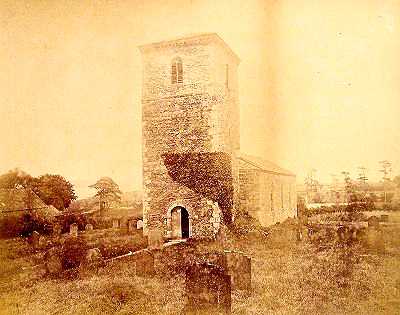 |
This is
the only known photograph of the church criticised by the Venerable W.B
Stonehouse in 'A Stow Visitation', above. It shows
an ivy
covered tower and the small nave erected by Thomas Goulton in 1797/8 to
replace the one illustrated in Nattes' drawing (q.v.) and
explains why it was necessary for parishioners to have a meeting to
allocate pews in their reduced church. This 'miserable structure' was
torn down in 1893 (q.v.) and replaced by the
present chancel
with a vestry at the S.E. corner. All but one of the scotch firs have
disappeared.....
Photo:
courtesy of Stephen
Ingram of
S. Ingram
& D. Robinson Ltd Bookbinders |
| The
photograph was taken by
William T. Watson (1835-1899) of Anlaby Road, Hull, probably in 1872. |
1851
A Religious Census in Whitton Alongside
the usual decennial Census of 1851 the Government authorised a survey
of Religious Worship.
Census enumerators asked representatives of the three places of worship
that they found in Whitton to fill in a questionnaire on Sunday 30th
March. Here are their answers:
ST.
JOHN THE
BAPTIST CHURCH rebuilt before 1800 by Thomas Goulton Esq. of
Walcot
Hall. Endowed with land £ 86-7s, other permanent endowment £ 1-5s, fees
10s, Easter offerings £ 15
Average attendance during previous 12 months.
In morning : General Congregation 50, Sunday scholars 20. In afternoon
: General Congregation 50, Sunday scholars 20.
'Teacher of the Sunday School confined; few of the Sunday scholars
attending Divine Service in consequence' Signed John Wilson, Minister |
WESLYAN
CHAPEL
Not a separate or entire building. Not used exclusively as a place of
worship. Free sittings 40. On 30 March, In evening General Congregation
and Sunday scholars 30.
Ave attendance during previous 12 months:
In evening:
General Congregation and Sunday scholars 30.
Signed Henry Naylor, Local Preacher |
PRIMITIVE
METHODIST CHAPEL Not a separate or entire building. Not used
exclusively as a place of worship. Free sittings 30.
On 30 March, In morning General Congregation 40. In evening General
Congregation 62
Signed Henry Richardson, Leader |
Notes:
If the figures are to be
believed, 162 of Whitton's 190 inhabitants attended Church or Chapel on
Sunday afternoon/evening . The Weslyans met in the White House at the
time. It is not clear where the Primitive Methodists met before the
construction of the tin chapel in 1905.
John Wilson ( 1777-1867 )
Henry Naylor ( 1831- ? )
Henry Morley Richardson ( 1797-1868 )
1854
When Whitton was a Port
The Sloop 'Walcot' was
built in 1854 by
John Wray, (1796-1884) Shipbuilder of Burton Stather for £ 380. Length
of keel 54' 6" , breadth of beam 14' 9", height 6' 6" from bottom of
keel to top of skin.
She
operated from the Whitton
landing place called the Stone Heaps, and later from the Pier
Photo - Collection of TMS
'Miss
Wells, the Postmistress says that her father's spade was used to cut
the first sod of the pier' (ks)
Note: If true, this would have been William Wells
(1838-1923) who was actually a shoe maker and Whitton's first
sub-postmaster .... |
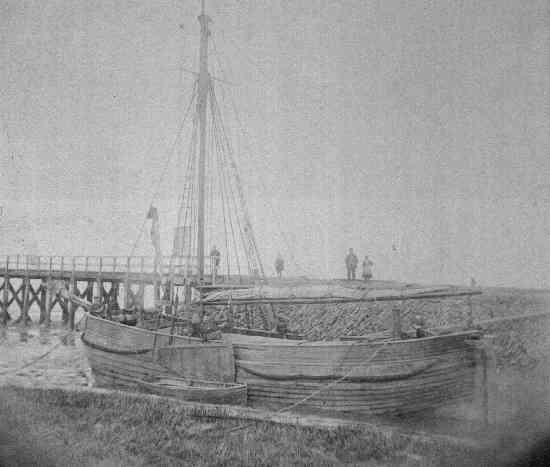
|
1856
Whitton, an extract from White's 'Gazetteer
and Directory of Lincolnshire'
WHITTON, a village and ferry at the
northern termination
of the Cliff range of hills, 0n the south shore of the river Humber,
about 3 miles below Trent-falls, and 9 miles west of Barton, has in its
parish 190 souls, and 1240 Acres l Rood 15 perches of land. The wife of
the Rev. W. H. E. Bentinck, archdeacon of Westminster, owns nearly all
the soil, and is impropriator and lady of the manor, which is parcel of
the Duchy of Lancaster. The Church (St. John the Baptist) was rebuilt
many years ago, when its fine Norman doorway was destroyed, but the
ancient font is still preserved. The vicarage, valued in K.B. at £ 6 1O
s. was augmented with £ 200 of Q.A.B. in 1767, and has been long united
with that of Alkborough. At the enclosure, about 90 years ago, land was
allotted in lieu of tithes. Opposite Whitton, there is, in the Humber,
a bed of silt, called Whitton Sands,
more than a mile
broad, and two miles in length, which is left bare at low water, and
upon which steamers and other vessels are often left aground till the
return of the tide. The ferry-boat here takes
passengers to and
from the steam packets or carries them across the river to Brough, or
Weighton Lock. In the gravel pit here, a very remarkable dip of the
strata is exposed, exhibiting, among the boulder stones, ammonites,
gryphites, and other fossils and shells, similar to those in the debris
on the shore, where many conglomerate masses have fallen from the
cliff; near the summit of which a petrifying steam oozes from an
incrusted rock.
Notes.
The wife of the Rev. W. H. E. Bentinck was Frances
Constable .
She married William Harry Edward Bentinck 19 July 1814 and died 13
March 1862 .
Q.A.B is Queen's Anne's Bounty - a money supplement to 'poor clergy',
with incomes less than £ 50 p.a., from fund established by Act of
Parliament of 1704.
Brough is 2.4 miles NE and Weighton Lock is 1.7 miles NW of Whitton.
Ammonites are fossils consisting of whorled chambered shells once
thought to be coiled petrified snakes and called in consequence 'snake
stones'. The name comes from their resemblance to the horn of Jupiter
which was called 'Ammon'. Gryphites are fossil oyster shells of the
genus gryphaea.
1856
A Pub in
Whitton The first mention of a public house in Whitton seems
to be
in the 1849 edition of 'White's Lincolnshire' when a pub 'The
Ferry
Boat ', with Robert Arnold (1791-1872) as licensee, makes an
appearance. It appears in the 1861 census, but has gone by the 1881
census. When the farm buildings, (cowsheds, gig-house, granary etc.)
immediately to the south of the pub were built in 1871, it was called,
the 'Steam Packet Inn' with John James Barley
(1849-1880) as
tenant.
The pub was, in what is now a private dwelling house with tumbled gable
roof called 'Village Farm' at the corner of Main Street and Post Office
Lane.
It must have been popular with the boat men and visitors waiting for
the ferry so why it disappeared is obscure. An elderly resident once
told the writer many years ago that there had been 'some trouble over
it'. That was all that could be remembered. There was a branch of the
Church of England Temperance Society in the village in the 1880s.
Nowadays the nearest pub is the 'Butcher's Arms'
in West
Halton. |
 |
1858
Diary of T Harris - "Letters
are brought from Winterton by a walking postman. Residents
have
no time to answer letters by return of post as the man leaves Whitton
directly he has delivered the letters."
Jan 7th He speaks of 'a gang of
plough jacks
going to Alkborough from Whitton'.
July
10th -'There is no
National School at Whitton but only a Dame's School kept by Ann Powell.
When therefore the boys and girls have learnt there to read and write
pretty well, they come to the National School here ( Alkborough
) and bring their dinners with them.'
Notes :A visit to the school on December 4th
1861 by the
Diocesan Inspector, Mr Read noted 27 girls and infants in one 'room in
a dwelling house, but sufficient'. He added '.....this is a small
Dame's school of small pretensions, supplementary (for girls and
infants) to the Alkborough school. There is no playground.....the
school fittings are of a simple kind'.
Dame schools were often run by women with few qualifications who
charged 3d or 4d per pupil a week and taught reading and writing to a
rudimentary level. Dame schools were often held in kitchens while the
"dame" continued with other household work - some historians think they
were little more than child minder services.
Thomas Harris was the 17 year old pupil of Rev Frederick Stockdale at
nearby Alkborough and his diary indicates the importance of Whitton, at
the time, as a ferry port:
"Jan
6th. Yesterday
Rev. F S. and I walked to Whitton to see the Reverend Lee (Master
of Chelmsford Grammar School) off by the Packet to Goole.
Jan. 2lst. Rev. F. S. went to Hull on l9th hired a Harmonium from Hull,
which Mumby brought from Whitton Pier on 20th.
Feb.3rd. By carriage from Kingerby to Market Rasen station, thence by
train to Hull, thence by Goole boat to Whitton.
Apr.l2th Rev. F.S left at 12.25 intending to go by the York boat which
passed Whitton Stoneheap at 1, but being too late he crossed in an open
ferryboat to Bruff and thence went by train to Hull and thence Kingerby
vicarage.
May 11th. Rev. F S. left at 3.30. pm. for Whitton thence to Goole, and
Doncaster to see about a new Infant School Mistress.
Jun.7th. Rev. Sheepshanks walked to Whitton and then crossed with ferry
boat to Brough and thence went by train to Leeds. " - T Harris |

The
Pier at
Whitton built 1865
|
Whitton
seems also to have provided
seasonal delicacies....
August 17th 'It is now the season for Humber Salmon-Trout, some are
caught at Whitton and brought round to sell. They are very good'.
1859 Diary of T Harris -" Nov
6th The sermon at
Whitton was so long that the congregation was not dismissed until half
past one".
1860 Diary of T Harris - "Jan
28th Three vessels
sank off the coast of Whitton; no lives were lost.
Feb 27th Another vessel wrecked, no lives lost."
Note:
Thomas Harris (1841-1907) went up to Jesus College, Cambridge in 1860
and subsequently became a priest. He died in 1907 shortly after
retiring from being vicar of Scotton and East Ferry. Surprisingly he
was Dean of Honolulu 1868-70.
1860
"We had a terrible hurricane
here on the 28th of May; the trees blown down on this estate were
counted by hundreds and on Sir Robert Sheffield's (at
Normanby)
by thousands". - Alexander Aitken.
1861
Census of 7th April reveals
the occupations of the people of Whitton, which at the time had a
population of 209 in 45 houses.
Agricultural
labourers
37
Female servants 10
Carters 7
Farmers 6
Dairymaids 3
Male farm servants 3
Ferrymen 2
Dressmakers 2 |
Millers
2
Nursemaids 2
Housemaids 2
Groom 1
Coal merchant 1
School mistress 1
Cordwainer 1
Grocer 1 |
Huckster
1
Inn Keeper 1
Housekeeper 1
Vicar 1
Curate 1
Bricklayer 1
Cow boy 1
Sailor 1 |
Note: The cordwainer
made
shoes. The huckster was a pedlar or hawker. The male farm servants
were unmarried
agricultural labourers, sometimes called 'servants in
husbandry',
who 'lived in' with the families of farmers.
|
1864
Whitton School The
present
stone and brick structure was built as a National School in 1864 with a
single schoolroom, cloakroom/porch and coalhouse, at the expense of
Lady Strickland (née Mary
Constable who had also built Alkborough Infant School ). It became a
Public Elementary School in 1893 and a Council School on 11 Oct 1930.
It closed 17 March 1943.
Elizabeth Wade (1795-1848) was referred to as the 'school mistress' at
her funeral and Ann Powell, is also listed earlier than the 1864 school
building opening, (see 1858) but they may have had to use their own
homes in which to teach. The new school was built on a piece of land of
almost an acre and has a plantation to its north, formerly used as a
shady play area and as an outdoor classroom on hot summer days . There
is a small triangular piece of ground to the south, formerly hedged,
which was used as a playground as well.
Notes:
1848 Elizabeth Wade mentioned as school mistress.
1851 Mary Hardcastle listed as school mistress in census.
1858 Ann Powell is the school mistress of a 'Dame's School'
1860-1876 Ann Green, school mistress
1892 Miss Charlotte Barley, school mistress Average attendance 28;
1893 May. Miss Denton was appointed to the post of Mistress of the
Whitton School which had been opened as a Public Elementary School
1896 Dec: Miss Emma Denton, school mistress resigns. Average attendance
32
1896-1899 Miss F Atkinson, school mistress
1899-1905 Dec Miss Ada Campbell resigns.
1906-1913 Mrs Eleanor Smedley, school mistress
1913 April 9-Nov28 Miss Clara Woods from Alkborough, temp
schoolmistress.
1913-41 Miss Lillian Ellis, school mistress
1941-3 Mrs Kathleen Tomlinson,
school
mistress
Whitton
School in the early 1930s,
as remembered by Jessie Grant née Burgess, appears as Appendix 4 below.
More
school photos - click here
|
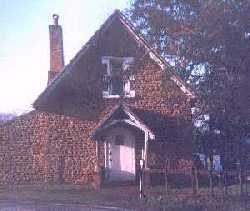
|
| 1865
Whitton
Pier In the 1860s, because the Stone Heaps were getting
increasingly difficult to use as a landing place for Whitton and
perhaps due to the success of the New Holland Pier, Lady Strickland
and the Walcot Estate
decided that the
village should have its own pier. In June 1865 a civil engineer from
Boston called Edward Welsh who was Surveyor and Engineer to the Witham
Drainage Commission submitted plans for a combined jetty/pier
structure, of total length 180 yards to be built about 400 yards east
of the Stone Heaps, close to where a stream emerges from the gladed
dell called the 'Plum' and falls into the Humber. It was constructed in
November 1865. |
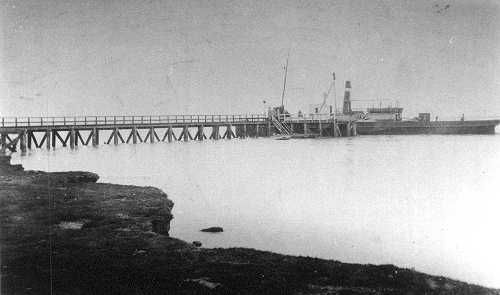 |
The
structure
consisted of a stone jetty sloping down to the water each side at 45 degrees,
and extending into the river beyond it, a wooden pier of about 200 feet
in length with a 12 feet wide walkway on top. At the pier end, a 40
feet landing stage extended east so that steam packets ( left ) could
easily embark passengers. Later an extra landing stage was built onto
the east side of the jetty. |
"There
was for many
years a pier here on which people wishing, could go on the steam
packets which went daily from Goole to Hull.
This boat was often very far from punctual and I have myself waited
often an hour before it has come..............The business of most of
the farmers was in those days done in Hull...and Whitton was quite busy
on Tuesdays and Fridays with the various people who were congregating
to take the boat for Hull. There was also a Market Sloop which ran
between Hull and Whitton on which corn, manure etc were brought to the
surrounding farms. This boat was in the joint ownership of Spilman and
Barley. Tom Barley acted as Captain for many years and the sloop was
moored at the jetty which was on the east side of the old pier landing
stage.(ks) |
1867
31 Oct. Rev John Wilson died
at the age of 90 . He had been Vicar for almost 50 years, having been
appointed in 1818. For some years he had suffered from an illness and a
curate, Rev F. Stockdale who lived at Alkborough,
had had to
be appointed. T Harris wrote 27 Aug 1857 'We walked to Whitton and
called at Mr Wilson's who is mad.'
Note : John Wilson had actually officiated at
his first
funeral, as curate, in June 1813 but on 20th May 1818 he buried the Rev
William Cookson and shortly afterwards was appointed to succced him.
1868
7 August. Rev Francis Exton is appointed to be vicar of Alkborough with
Whitton.
1873
August 29th A collision
in the Humber
between the steamers Emily and Londos,
of Goole.
The Emily sank on Whitton Sand.
December. A fog bell was installed at the end of Whitton Pier and then,
in November 1875, Hull Trinity House told the Board
of Trade
that they proposed to place a permanent 'Floating Light Vessel' at
Whitton Ness in place of a temporary vessel (built by John Barley),
that had been in use since 1865. The new vessel (right ) was
built by Richard Day
of New Holland for £ 380 and was put in place on Jan 31st 1877. |
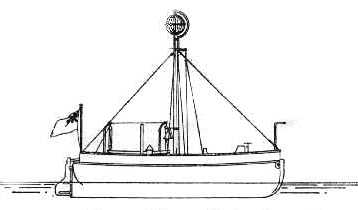
The Upper Whitton Lightship of 1877
|
1874
Whitton votes...or did it ? In the General Election of
January
1874 (which Mr Gladstone had suddenly called, promising to abolish
Income Tax if he were returned to power) there were actually only eight Whitton people out of
a population of 200 who were eligible to go to the polling place at
Winterton to vote ...
The Reform
Act
of 1832 had extended the franchise by means of various
property qualifications and five male villagers (below left) were
entitled to vote by reason that they paid rent of more than £ 50. The
second Reform
Act of 1867 increased voting rights in rural areas, to
occupiers rated at £ 12 a year or more, and so added three extra voters
( below right ). |
Occupying
land with
rental £ 50 plus
William Blanchard (In the town)
William Millson Langton (South end)
Joseph Naylor (Bishopthorpe)
Thomas Spilman (South end)
Thomas Wilson (Longlands, Argands & Robcroft) |
Occupying
land with
rental between £ 12 and £ 50
John Barley, sen. (North end of town)
John Barley, jnr. (North end of town)
Walker Green (In the town) |
Whitton
did not
actually vote in 1874; the Liberals failed to put up candidates in the
North Lincolnshire Constituency and so the two Conservatives (Rowland
Winn of Appleby and Sir
John Dugdale Astley of Elsham) were returned
unopposed.
Notes : Mr Gladstone lost and it was the
Conservative,
Benjamin Disraeli who won the
election.
In 1951 (q.v.) out of a population of 173, all 125
adults in
Whitton over 21 were eligible to vote .... |
1880 James Goulton
Constable
criticises Whitton School, built by his grandmother
Lady
Strickland in 1864.
The owner of Whitton shows his reactionary side in a
book he publishes in 1880:
'The education of the
masses in our
rural districts is in these days being very much overdone .….. What is
the use of teaching a child of four that a certain shape is called a
parallelogram and that another certain shape is called a trapezoid
? Much use will such knowledge be to him when he is set to
tent a
field or to cut up turnips for sheep, or to feed pigs even supposing
the shape of the field to be a parallelogram and he himself careful to
cut up his turnips into the most complete trapezoids. … he is then
taught what is the highest mountain in Carnarvonshire and what relation
Edward the Black Prince was to his
uncle.
Knowledge such as this must, of course, be of immense importance to a
lad when he is set to drive a plough…'
Source: J. G. Constable, The anatomy of wealth, or, The
ABC of every day life (York, 1880), p.87 ; 'to
tent' is to look after, or guard.
Note: James
Goulton-Constable (1850-1922) was the principal
landowner of Whitton; born in Cotesbach, Leics , he lived at Walcot
Hall with his wife Mary and son Lewis. In 1873 he is recorded as owning
a total of 2,975 acres with an annual rental value of £ 4681-7-0 . Source:
J.Bateman (ed.),The
great landowners
of Great Britain & Ireland (1873), p.102
See 1919, below, for more about James
Goulton Constable.....
1882
The Charities of Mary Anne
Bord and Nathaniel Easton. In 1882 Mary Anne Bord in her
will,
left the interest on £ 47-9-7 for the purchase of flannel to be
distributed annually amongst the oldest widows who were not in receipt
of parochial relief and four years later, in a codicil to Nathaniel
Easton's will of 1886, the interest on £ 133-3-4 was bequeathed for the
poor and deserving inhabitants of the parish. The two charities were,
effectively, combined in 1908 and in the early days gifts were made of
meat and flour to eligible Whitton parishioners; then for many years,
quantities of coal were supplied just before Xmas, until its purchase
in bulk became impossible because of wartime rationing. Cash payments
then took the place of coal.
The charities ceased to operate as recently as September
2010. See the website.
Mary Anne
Bord was
born
in 1813, the daughter of Whitton farmer, Thomas Butter. She married in
1843 a clerk at the Bank of England called Richard Bord. After his
death in London she, 'a widow lady of independent means' and her son
came back to north Lincolnshire to live. A life-long epileptic, on the 20th June 1882, she took by
mistake 'chloride of
lime' (powdered bleach)
and
died on the 22nd June. She
was buried in the family plot in Whitton churchyard- Hull Packet and East Riding Times,
Friday, July 7, 1882.
Nathaniel
Easton was
born in Barton in 1818 of a family that had been in Whitton since the
early seventeenth century. (The Whitton register has Ellen, daughter of
William Easton, being baptised in 1610, for example).
Nathaniel was a successful auctioneer and valuer, in
Bowlalley Lane Hull,
for
many years, before retiring to Torquay and dying in 1886 aged
67.
|
1887
21st June "The Jubilee
of Queen Victoria was celebrated at Whitton by a special
Church
service at 11am. A cricket match , Married v Single was played and
Single won by 7 runs. At 4.30pm a tea in Mr Edward Naylor's barn at
which 140 sat down After tea, sports were indulged in. Shortly before
11pm a bonfire was lighted on the summit of the
hill-top. The children above five were entertained by Mr Goulton
Constable at Walcot." (ks)
Note: The day after
the 50th anniversary of
the accession, Tuesday the 21st, was declared a bank holiday.
|
| Whitton's
windmill
stood in Mill Close a 1.84 acre field now part of Mill Field , just to
the south west of the village. It was a four sail tower mill with a
circular brick body and a timber cap, which contained the windshaft.
This meant that only the cap had to turn to face the wind.
When
it was demolished the mill
stones were taken and used as the centrepieces of raised garden beds at
Grove Farm.
In the 1950s the remains of the mill's foundations were still to be
seen, but even these have now been removed and a slight mound in the
field is all that remains of the site.
|
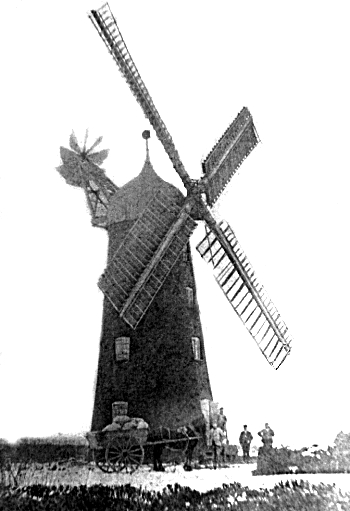 |
1889
December
The Parish Magazine says “ This Church is in a very bad state. The roof
is very rotten, large patches of plaster having fallen off and the rain
coming in, in several places. The walls also appear in a bad state but
these can be adapted with a re-arrangement of the windows and
re-building of east wall “
There are many accounts subsequently of money being raised - the sum
needed being £800.
1892
KELLY'S
DIRECTORY
BARLEY John vessel owner
BARRETT George farmer
BLANSHARD William farmer
DUNGWORTH Robert Henry-miller (wind)
LAMMING William farmer
MORWOOD Harriett, Mrs shopkeeper |
NAYLOR
Edward farmer
NAYLOR Joseph farmer, Bishopthorpe
ROBINSON Thomas farmer
SPILMAN Thomas farmer
WADE Dan shopkeeper
WELLS William shoemaker |
1893
A Post Office in Whitton seems
to have been set up for the first time in this year in a cottage on
what is now called Post Office Lane. Its first sub-postmaster was
William Wells, the village cobbler (1838-1923) and he was followed in
the role by his daughter Miss Florence Jane Wells (1874-1967) . She was
succeeded in the job by Miss Gwen Bullivant (1902-1981) and the Post
Office was in a curtained part of her front room with a Post Box set
into the outside wall. (To this writer, when as a
small child, sent to the
post office to buy stamps, the sudden dramatic appearance of Miss
Bullivant from behind her curtain will always remain a traumatic memory
).
In 1978 the Post Office moved
to Mrs Kirkby's
shop in Main Street and the post box followed it. In the 1980s it moved
again and for a little time was in a house in Old Mill Lane, but now
Whitton is without a Post Office.
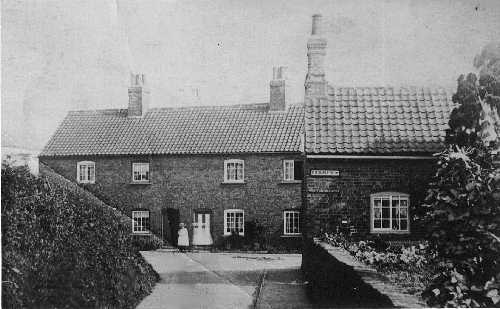 |
The
original Post
Office cottage is seen on the right of the photo.
The white sign says 'Telegraph Office ' and the smaller black one
below, 'Whitton Post Office'. Later the Post Office moved a few yards
to the cottage in the middle of the photo. A child in a white dress,
standing outside, has moved while the picture was being taken and her
image appears several times... |
1893
May 1st 'Free
Education' comes to Whitton.
'Miss Denton was appointed to the post of Mistress of the Whitton
School which had been opened as a Public Elementary School and as the
parents are now, at any rate for the present, able to send their
children free of expense, a Penny Bank will be opened'. (ks). Thirty
children had appeared on the first day, seventeen below the age of
seven years old.
4th May. Mary Goulton Constable paid a surprise visit to check the
register against the number of pupils present. She noted 37 - correct.
Notes : The Elementary Education Act
of
1891 provided that
a 'fee grant' at the rate of ten shillings (50p) a year be paid to
every 'efficient
elementary school for each child between the age of three and thirteen
years in average attendance'. It was thus possible to discontinue the
practice of 'school pence' whereby children would bring a sum of money
(perhaps 2d or 4d) each Monday morning to pay for their
education. It
seems that in Whitton an attempt was made to divert this money into
savings.
Emma Denton had been born in Hull in 1849 and was a Certificated
Teacher.
Education was now suddenly popular with the parents of Whitton.... |
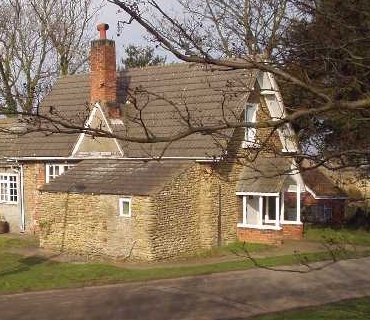
|
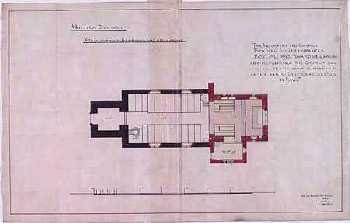
|
1893
May “ The
Parish Magazine says :"We are all rejoiced to see the work of
Restoration is now fairly in hand. The weather has been most propitious
so far. The east end of the Church, or what did duty for a chancel
having been pulled down, some beautifully carved bases of pillars,
clustered columns etc. having been brought to light proving that the
older Church had been a very fine one, very different from the
miserable structure afterwards erected in its place".
|
| Note:
The restoration was
under the direction of William Bassett-Smith (1830-1901) of 10 John
St., The Adelphi, London. His ground plan is shown above. |
| 1894
April 11th
“ The Church was reopened. The day was lovely. The bells rang merrily
at intervals. The day began with the celebration of Holy Communion, the
bishop Celebrant ( Edward King, Bishop of Lincoln).
And there
were 38 communicants. Eighteen clergy attended at the 11 o’clock
service and the Church was crowded. Afterwards luncheon was held in Mr
Dann’s barn, the bishop being present. The Chancel is entirely new,
also roofs and windows. The Sanctuary with its new hangings and
properly vested Altar gives a very dignified appearance". |
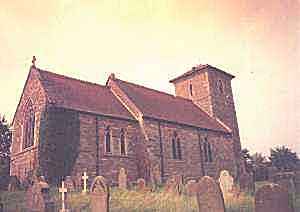
|
1894
20th August 'Frank
Holgate Barley was drowned when making ready to leave with a cargo of
hay from Whitton jetty - his body was recovered at Burton Stather'.
(ks)
Note: He
was 27 and was the mate on his
father's Humber Keel ; his body was washed up near Burton on the 28th
August. His son, also Frank Holgate Barley born October 9th, (whom
he never saw ), was killed in WW1.
"For the
first time in the memory of man,
which substantially is the first time in the world's history, a
confirmation was held at Aukboro' " (ks)
December
4th, Tuesday - The first Parish
Meeting under the 1894
Local Government Act (which had
established
civil parish councils) was held in the schoolroom. Edward
Naylor.
took the chair on a show of hands of the 17 electors present. The
Parish Meeting decided unanimously, not
to petition the
County Council to order the election of a Parish Council.
1894
Whitton in the House of Lords On
the night of 21st/22nd December 1894 the Whitton No.2 lightship broke
loose in a violent gale and drifted towards the Lincolnshire shore near
Read's Island. A team of local 'punt gunners and smack owners' saved it
from becoming wrecked and claimed salvage from its owners, Hull Trinity
House. They refused to pay up on the grounds that a lightship was not a
'ship' and so was not subject to the laws of salvage. The Yorkshire
County Court said that it was a ship; next the
Admiralty
Division said although not a ship, it was still
subject to
salvage. The Appeal Court said it was not a ship
and not subject
to salvage and finally, on 24 Mar 1897, the House
of Lords agreed with the Appeal Court so no salvage money was paid....
1895
April.
"The Magazine speaks of a bazaar held on the Hill Top and says 'having
the festivities at Whitton will be a novelty'. This was for Church
restoration funds - unfortunately these festivities were spoilt by a
terrible thunderstorm." (ks)
1896 The bazaar held in
aid of the Tower Fund
in July 1896 on the Hill Top was "attended by people who came from Hull
on the 4 o'clock boat..." (ks) |

Click to see
Whitton from the air |
1896
KELLY'S
DIRECTORY
BARRATT George parish clerk
BARLEY John vessel owner and coal merchant
BELL Emma, Mrs shopkeeper
BLANSHARD William farmer
DANN Sarah, Mrs farmer
DUNGWORTH Robert Henry -miller (wind)
GERALD Rev. Arthur curate
LAMMING William farmer
MORWOOD Harriett, Mrs shopkeeper |
NAYLOR Edward farmer and overseer of the poor
NAYLOR Joseph farmer, Bishopthorpe
RIPLEY George farmer
SPILMAN Thomas farmer
WADE Dan shopkeeper
WALKER Grace shopkeeper
WELLS William shoemaker (and Sub-postmaster seen
here with his wife Harriet (1838-1912) outside the Telegraph and Post
Office. ) |
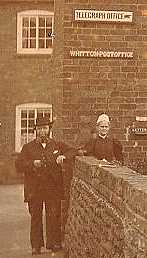 |
POST
AND TELEGRAPH
OFFICE: Sub-postmaster William Wells. Letters via Doncaster and
Frodingham arrive at 9.30 a.m. and are despatched at 4.45 p.m. Postal
orders are issued but not paid.
NATIONAL SCHOOL (MIXED): Schoolmistress Miss Emma Denton. Average
attendance 32 |
1897
The Diamond Jubilee of Queen
Victoria was celebrated in Whitton by the planting of a tree, and a
suitably engraved stone was placed at its base. Unfortunately the tree
died and the stone was moved, for safe keeping into the front garden of
Cliff House, where it remains to this day.
1899
March 20th The Parish Meeting
examined plans to build a Light Railway from Frodingham to Whitton with
branch lines to Winterton and Winteringham and were strongly in favour
of the scheme. However it was not to reach Whitton until 1910, below.
1900
Mafeking not
relieved. May 15th 'School holiday in honour of the Relief of
Mafeking '.
May 16th 'We were a little premature with the above holiday, owing to
mistaken news' - Ada Campbell, schoolmistress.
Note: Happily the Boer siege of this Cape Colony
hamlet was
ended by "C" Battery, Royal Canadian Field Artillery at 4:00 a.m. the next
morning, 17th May 1900. Whitton school
children did not
get a further day's holiday.
1900
"Miss Bell at the shop can
remember the Parish Clerk, Mr George Barratt, collecting Easter Dues
(2d per person over 16 ).They had to be collected before 12 midday on
Easter Monday. They stopped in about the year 1900." (ks)
Notes: Probably the George Barratt born in
Whitton 1833
died 1906.
Easter Dues was money due to the clergy at Easter,
formerly paid
instead of the tithe for personal labour.
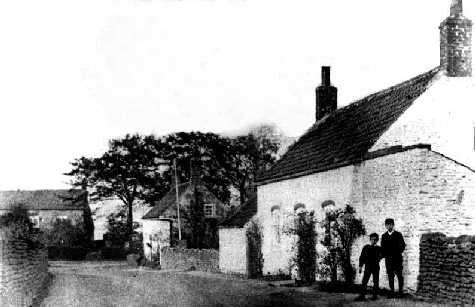 |
Looking
down Chapel
Lane towards the old Vicarage, now called 'Prospect House'. The River
Humber can be glimpsed through the trees...
The
white cottage on the right,
with the children outside, has acquired an upper storey, but the white
cottage at the bottom of the lane remains seemingly unaltered.
|
1901
March 2nd. A large whale 43
feet long and 7 feet across the tail weighing about 20 tons swam past
Whitton into the Trent, where it was stranded on the 'Brickyard sands' between Flixboro' and
Burton and shot.
1901
The Barleys of Whitton The
census of 31st March 1901 records that thirty-five (35) or one
in
five of the 173 inhabitants of Whitton had the surname
Barley. They
ranged from 79-year-old John Barley and his 75-year-old wife Hannah to
the newly born Holgate aged just 3 weeks and included five men who
worked on the River Humber. The first Barley in Whitton may have been
John, (perhaps born Flixboro' 1764 ) who came to the village to marry
Mary Cross in 1785 - their child James was born in 1787. There are
a large number of Barley graves in Flixboro' Old
Churchyard.
1902
Plough Monday Jan 7th.
'School obliged to close for the day as only seven children turned up,
it being 'Plough Jack Day' ; some old custom which is still kept up ' -
Miss Ada Campbell, schoolmistress 'till Dec 1905.
Note: The Monday after Twelfth Night, when farm
work was
resumed after the Christmas holidays, was known as Plough
Monday.
In
olden times ploughs were blessed and decorated and dragged around the
parish by plough-boys, known as Plough Jacks or Jags, who demanded
food, drink and money. Mummers' plays were performed, which enacted
ritual combat and symbolic death and revival.
1903
The first parish meeting
under Arthur Balfour's Education
Act
of 1902, which provided much
needed money for elementary education, was
held on 27th March 1903. Rev. Benjamin
Hunter, Chairman and
Thomas Spilman, Secretary.
Note: The Act made
education the responsibility of local
government through new local education authorities . The board schools
(like West Halton) became council schools and the voluntary C of E
schools (like Whitton) were subsidised by public funds. This was
controverisal because non-conformists did not wish to pay for a
religious education with which they disagreed.
1906
Whitton's strangest funeral. On
the morning of the 26th June 1906 the sight of a wreck, the sloop Masterman,
presented itself
close to the foreshore, embedded in Whitton Sand. A telegram was sent
to Brough and it was learned that the crew had managed to escape and
had landed there, but that five women had been trapped below, in the
cabin and had drowned. They were Mary Ann Barr (46) of Hull and her
four daughters Emily Eastwood (20), Frances Barr (15), Jane Barr (9)
and Joy Barr (7). The bodies were never recovered but the emotion in
the village was so strong that the vicar decided to hold a funeral
service for them. Their names were entered in Whitton's burial
Register, but the funeral rites on Friday 27th July 1906 were held, not
in the
Church, but in a boat moored in the River Humber above the wreck 'where
they are, in a manner, buried' wrote Rev. Benjamin Hunter in the
Register..
1907
Infectious diseases were both
common and serious before vaccination became universal. This year saw a
measles epidemic in Whitton and the school was closed by the medical
authorities from May 23rd till June 17th.
1908
Feb 17 ' Frank
Holgate Barley left school today at the age of 13, because he had made
sufficient attendance during the last 5 years to gain Exemption' - Mrs
E Smedley, schoolmistress.
Note: Normal school leaving age had been raised
to 14 in
1900, but young Frank, needed to earn a wage for the family as his
father had been drowned in 1894. Unfortunately he was to be killed in
the Great War at the age of twenty-two and is remembered at the Menin
Gate at Ypres......
1909 Old
Age
Pensions Act
of 1908
came into force on Jan 1st and Whitton Post Office began paying
villagers over 70 whose yearly means were not more than £ 21.50 per
year, a
non-contributory pension of 5 shillings ( 25p) per week . To qualify it
was necessary to have lived in the U.K for 20 years and to have not
been in prison for 10 years, nor to be a 'drunkard or malingerer'.
This Act, at a stroke, removed the threat of the workhouse from the
aged cottagers of Whitton. Thus ended the worst effects of the Poor Law
Amendment Act of 1834 and presaged the end of the Brigg Workhouse - see
1819 above .
1909
KELLY'S
DIRECTORY
BARLEY Holgate coal merchant
BARLEY Thomas potato merchant
BELL Emma, Mrs shopkeeper
BLANSHARD William farmer
DANN Sarah, Mrs farmer
DOOK Charles farmer
NAYLOR Thomas threshing machine propr.
NELSON Frank farmer, Bishopthorpe
SHORT Frank miller (wind) |
SPILMAN
Thomas farmer
and overseer of the poor
VESSEY Edward farmer
WADE John shopkeeper
WELLS William boot and shoe repairer and sub-postmaster
WOOD William Henry blacksmith
WALKER Rev John curate
SMEDLEY Eleanor, Mrs schoolmistress (average attendance 26)
|
A
Blacksmith's Shop in
Whitton Just as one enters the village, on the left, at the
bottom
of a slight incline, now called Blacksmith's Hill, stood Whitton's
Smithy. It was a small building of stone and brick with a tiled roof
and large double wooden doors. In the 1930s it bore an A.A. roadsign
with the words - 'Whitton. 176¾ miles to London'.
When the blacksmith was working, the doors were opened wide and
passers-by could see the rear of the horse and the red glow of the
forge . As well as shoeing the horses, the smith was also responsible
for fitting steel tyres to the wheels of carts and wagons, and for
making and repairing metal fittings on other items, from wheel-barrows
to ploughs. The Tophams of Alkborough seem to have been Blacksmiths in
the later part of the 19th century,and Charles Wright is also mentioned
in Directories. Wm Henry Wood (born Thealby in 1855) who lodged at
Burton Stather is listed as smith in 1909 and 1919. The last smith may
have been Thomas Edward (Ted ) White who lived at Alkborough. Like the
smiths before him he had several shops in neighbouring villages and
travelled from one to the other on different days of the week.
The Smithy closed sometime at the end of the 1930s. By the 1950s it was
a tumble-down ruin and children were warned to stay away from it. Now
it has completely disappeared and a small plantation of trees, on about
90 sq. yds of land, marks the place where it once stood.
Note: The A.A. sign was removed in July 1940 along
with other
roadsigns, due to the threat of enemy invasion.....
1910
The Railway
comes to Whitton
| This
branch of the North
Lindsey Light Railway was built to service the iron ore
workings
to the north of Scunthorpe. The first section to West Halton from
Scunthorpe was opened in 1906. It was extended to Winteringham in 1907,
and a short line was constructed to the Humber bank where it linked
with a cargo ferry to Hull. The final stage was the line extension to
Whitton which was opened on 1st December 1910, where it also connected
with a packet sailing between Gainsborough and Hull operating three
days per week. It was hoped to link the line with the Fockerby branch
line on the other side of the Trent but this did not happen. |
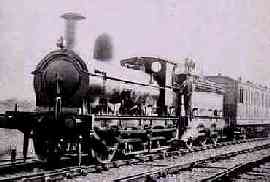
|
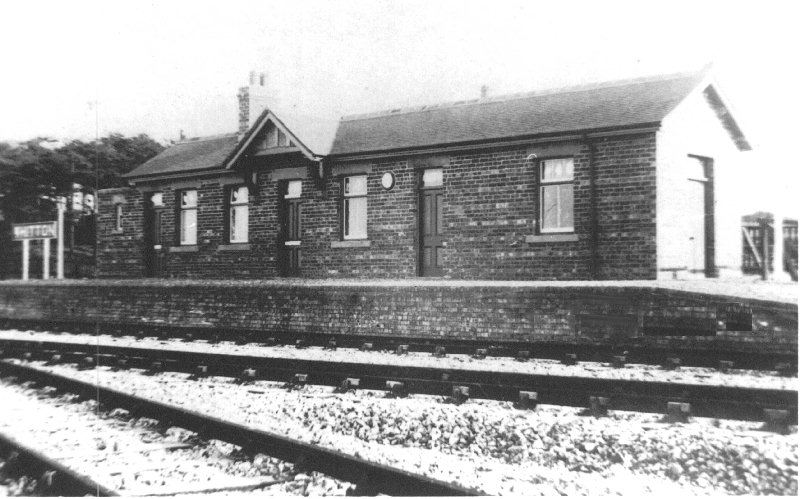 |
Passenger
traffic was light and
ceased in 1925.
Freight continued for some time after, but the West Halton to Whitton
section finally closed to all traffic on 11th October 1951.
A section of this had been used for wagon storage in the war years - see
1939 below.
Left
: Whitton Railway Station
|
1910
The Cinema comes to Whitton '
January 9 1911. Reopened school after Xmas holidays of 2 weeks, 23
children present. During the holidays L. Constable Esq. gave the
children a treat consisting of a cinematograph and tea in the
schoolroom, after which oranges and crackers were distributed.'- Mrs
Smedley, head teacher from 1906 till 1913.
Notes: This was on 29th December 1910. Lewis
Robert
Goulton-Constable (1877-1946) was the son of the owner of Whitton.
1911
May 1st Whitton School
Register
| Standard
6: Percy
Bullivent, Fred Peake, Albert Standerline |
| Standard
5: Sydney
Cowling, Maud Barley, Florrie Parrott |
| Standard
4: Stanley
Short, Gwennie Bullivent, Jessie Standerline |
| Standard
3: Nil |
| Standard
2: George
Barley, Stanley Cowling, Doris Barley, Florrie Standerline, Doris
Cowling, Annie Hurd |
| Standard
1: Harold
Peake, Arthur Parrott, Edith Short, Clifford Hurd |
| Sixes
: James Barley,
Harold Hurd, Ethel Bullivent |
| Under
5: Ellen Cowling |
Note:
Nobody was without a
relative in the school room.
Four Barleys and Cowlings, three Bullivents, Hurds and Standerlines,
two
Parrotts, Peakes and Shorts = 23 pupils.
1912
Sunday 21st April 6.30pm. A
service
was held in Whitton Church to commemorate the loss of the liner 'Titanic' on th 15th.. The Rev
William H
Prichard preached and took
as his text, 2 Corinthians IV 18: 'While we look not at the
things
which are seen, but at the things which are not seen: for the things
which are seen are temporal; but the things which are not seen are
eternal.' The
collection raised
9/2d (46p).
1912
Crop Failure. A year of
unusually bad weather in Lincolnshire with a notably wet March soon
followed by twice the average rainfall in the months of June, July and
August and an unseasonably cold August, September and October. In
Whitton much of the wheat and barley in the fields could not be
harvested, because, in the damp, the grain sprouted on the stalk, and
was ruined. Many acres had to be ploughed back into the soil.
| 1913
1st
December. Lillian Ellis (right) took over as
schoolmistress of
Whitton School from Mrs Eleanor Smedley (1863-1928) who retired due to
illness.
Miss Ellis taught the children of Whitton until 27th October 1941 when
she herself retired, and the school's final teacher, Mrs Kathleen
Tomlinson (née Dann ) of Thealby who had been working at Winterton,
took charge.. |
 |
1914
The Great War August
3rd 'Bank Holiday not be taken this year as the managers (of
the
school ) have fixed Friday 7th for the closing of the
school for
the Harvest Holidays'.
August 4th '11pm War declared'.
August 7th 'School closed for the Harvest Holidays'.
August 31st 'School re-opens'.
September 18th 'School closed for the potato picking holidays for one
month'.
October 19th ' School reopens. Papers received concerning the War . Had
lessons on 'War'and 'Trafalgar Day'. - Miss Lillian Ellis
1915
The 'Audrey', built by
Joshua Watson at Gainsborough in 1915, was one of three vessels which
marked the treacherous sandbanks serving as middle, upper and lower
Whitton lightship.
In years gone by there was a jingle among sailors and Whitton villagers
which warned of the dangers:
'Between Trent Falls and Whitton Ness, many are made widow
and
fatherless'.
The 'Audrey'
was bought by the Sobriety project in Goole in 1986, and
has undergone refurbishment costing £ 75,000. She has been converted to
the gaff-rigged ketch 'Goole Billy Boy', which is a sea-going version
of a Humber keel or sloop. The 'Audrey' is now mainly used to give
disadvantaged young people and community groups a taste of life on the
water.
1916
Aeroplanes appear over Whitton An
airfield across the river and a seaplane site on
the river
were established in 1916 for the production and testing of their early
aircraft by the Blackburn Aircraft Company at Brough.
Aircraft
production increased in the 1930s and it became very busy modifying US
lend-lease aircraft as well as producing its own aircraft. After the
war many Whitton people will have seen the Blackburn
Beverley
heavy-lift transport aircraft lumbering into the air over the Humber.
Today, the factories are still producing parts for British Aerospace.
The airfield is still used, though the shortness of the longest runway,
(1054m) means that Whitton will only see the light
aircraft
that can use it.
 |
1918
13th March
'School opened at 9.30 as a heavy bombardment or air raid kept many of
the children up last night and early morning'- Miss Lillian Ellis. |
| Note: This attack
of 12/13 March
was the last airship raid of the Great War and was carried out by
Zeppelin L.63 (above). A total of 12 bombs were dropped on Hull and the
surrounding countryside. |
1918
Whitton lost three soldiers
in the Great War -
Pvt Frank Holgate Barley, 11th Bn, Sherwood Foresters died Sat, 14th
April 1917. Age 22. Ypres, Belgium
The
son of Frank Holgate Barley,who
had been in drowned August 1894 and of Alice Barley.
Cpl Henry Spilman, 8th Bn, East Yorkshire Regiment died Wed, 2nd May
1917. Age 21, Etrun, France
There
is a memorial window to him in
the church .
Cpl Harry Standerline, 1st Bn, Lincolnshire Regiment died Fri, 23rd
April 1915. Age 28, Ypres, Belgium.
Son
of Charles and Hannah Standerline.
An illuminated scroll in the church also records the following, who
served in the Great War and returned to Whitton:
| Percy
Charles Barley |
Royal
Naval Reserve |
Frank
Kew |
Durham
Light Infantry |
| Fred
Bee |
Royal
Navy |
Tom
Standerline |
East
Yorks Regiment |
| John
E Bullivent |
Royal
Engineers |
Alex
Waddingham |
Sherwood
Foresters |
| Fred
Cowling |
Lincolnshire
Regiment |
|
|
1918
Influenza December 1st.
'School closed by order of Dr Clegg as influenza prevalent here.
Mistress and assistant both ill with it, also many of the children.
Many deaths in the neighbourhood. '- Miss Ellis
The Xmas holidays were prolonged and the school finally reopened on Jan
13th 1919
Note: The influenza pandemic of 1918-19 killed
more people
than the Great War, at somewhere between 20 and 40 million people. It
has been cited as the most devastating epidemic in recorded world
history.
Charles Standerline (1844-1918) was the only Whitton death in this
period, but his demise, on the 5th December, was certified as due to
'senile decay'.
Looking
south down
Main Street, at the junction with Post Office Lane.
On the right a child ('Hetty' Bell?) sits on the front step of the
grocer's shop. The shoemaker's shop is the tiny building next door.
Fred Bell bought the three bedroomed cottage with both shops, a garden
and various outbuildings including coal house, cow sheds and pigsty,
for the sum of £ 100 in the 1919 Whitton sale. |
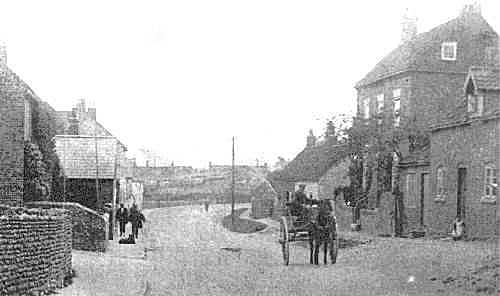
|
1919
Wednesday November
12th; Whitton
is sold by
James
Goulton Constable for £ 46,433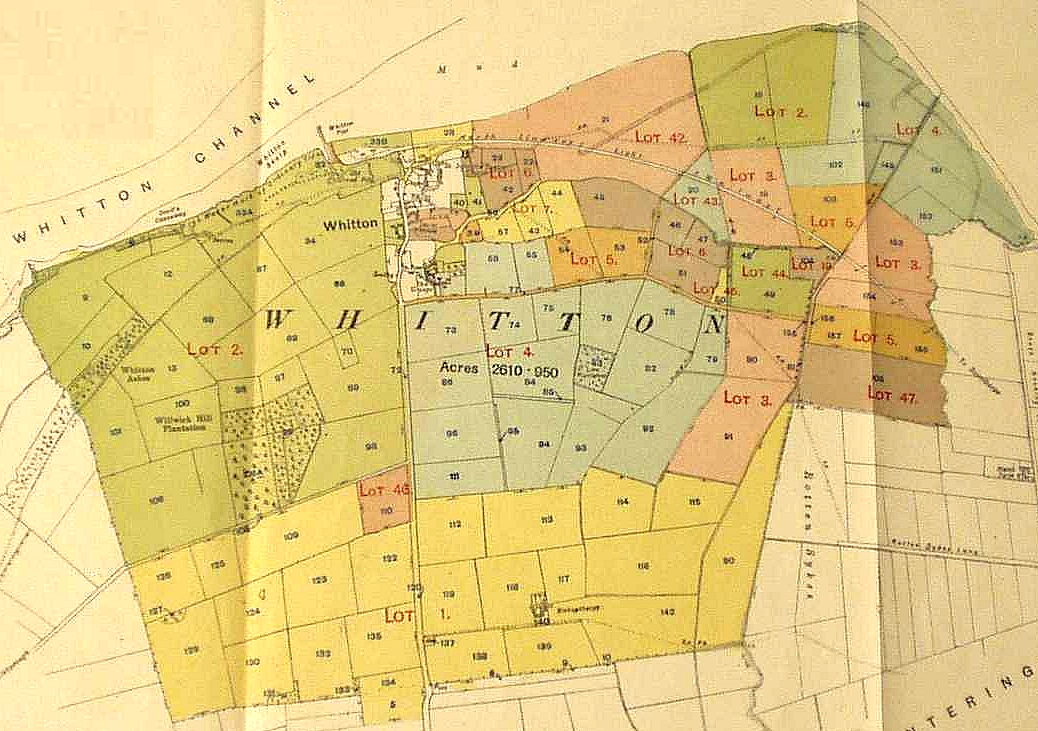
|
DESCRIPTION
TENANT A.R.P. |
DESCRIPTION
TENANT A.R.P. |
|
|
1
Bishopthorpe
Farm,
Mr. F. Nelson, 330.3.1
£ 11,700
2
The Grove Farm,
Mr. L. Spilman, 372.1.8
£ 9400
3
Manor House
Farm,Oxtoby
£ 3000
Mr. E. Dore 95.3.36
4
The Grange
Farm,D
Jones £ 7600
Mr. C. R. Dook 279.2.10
5
Farm, Ferraby
£ 2600
Mr. W. C. Jarvill. 54.3.32
6
Dairy Farm, Vickers
£ 1500
Mr. E. Vessey, 39.3.32
7
Small Holding,
Mr. T. Naylor, 20 2 34
£ 920
8
Cottage and
Garden, L.Spilman
£ 110
Mr. H. Cowling, 1. 29
9
Cottage and
Garden,L.Spilman
£ 100
Mr. J. Barley, .37
10
Garden, Mr.
J. Barley, 1 .15
Mrs
Bentham £ 28
l
l School and
Plantation,Mrs
Bentham £ 135
School Trustees 3. 34
12
Cottage and
Garden,
Pacey £ 90
Mr. T. Thornton,.35
13
House and
Garden F.Harris £ 335
Mr. S. Spink, 1 .11
14
Cottage,
Grocer's and
Shoemaker's Shop with Garden
Mr. F. Bell ,.35
£ 100
15
Garden,
Mr. F. Bell, 2. 5 Ferraby
£ 20
16
Blacksmith's
Shop, Phillips
£ 50
Mr. W. H. Wood, .3
17
Cottage,
Garden and Arable Field
Mr.W. R. Cook, 1 1. 7
£ 225
18
Cottage and
Garden, L Spilman £ 95
Mr. H. Hare, 1 .16
19
Cottage,
Garden and Paddock £ 340
Mr. M. Bray 6 .1. 22
20
Cottage and
Garden,Allenby
£ 100
Mr. E. Cowling, .30
21
Cottage,
Garden and Field, Phillips
£ 160
Mr. W. Barley, 3 .34
22
Cottage and
Garden and 2 Fields
Mr. T. Barley, 3 .2. 24
£ 250
23
Cottage and
Garden, Phillips
£ 140
Mr W. Breighton, 3. 35
24
Pair of
Cottages,Allenby
£ 130
Mr. S. Foster, Mr. H. Birkett 1. 14
|
25
Cottage and
Garden,
Mr. F. Short 3. l6
£ 165
26
Two Cottages
and Gardens
Miss M. J. Barley, Mr. G. Wade 2 .14
Miss M. J. Barley £ 200
27
Cottage and
Garden,
Mr. G. Hewitt, 1. 21 Jones
£ 235
28
Cottage and
Garden
Mr. J. Cowling 1. 3 Rowbottom
£ 90
29
Cottage and
Garden
Mr J. A. Wade, 3. 1
£ 275
30
Chapel Site
and Garden,
Chapel Trustees and Mr. J. A. Wade, .31 Trustees
£ 25
31
Cottage and
Garden,
Mr A Bullivant, 1.33 Ling
£ 125
32
Garden,
Various, 2 .2 Mrs
Bentham £ 35
33
Garden, Mr M
Bray, 1.7
L.Spilman £ 10
34
Cottage and
Garden,
Mr. W. Wells, .27
£ 150
35
Cottage and
Garden,
Mr. A. Stockford 2. 13 Hewitt
£ 170
36
Cottage and
Garden,
Mr. G. H. Barley, 2. 24 Foster
£ 140
37
Cottage and
Garden
Mr. T. Coulam, 2. 16
Naylor £ 110
38
Cottage and
Garden
Mr. J. Waddingham, 3. 6
£ 180
39
Cottage and
Garden,
Mr. B. Holgate 2. 5 Naylor
£ 140
40
Four Cottages
and Gardens
Mr. J. W. Wells and others, 3.37Geo
Wade £ 320
41
Whitton Pier
and Coal Wharf G
Davey £ 310
Mr. T. Barley 2 .12
42
Grazing Land,
Various 67. 1. 8 Waite
£ 2200
43
Grazing Land,
Various 8. 3. 30 Killick
£ 350
44
Plantation
and Grass Field
Various 15. 2. 22 Allenby
£ 500
45
Grazing Land
Various 1. 1. 36 Allenby
£ 60
46
Grass Field
and Road Frontages
Various 8. 3. 18 Phillips
£ 300
47
Grass Field
(Argons)
£ 1200
Mr. T. L. Spilman, 28 .1. 2
|
Whitton
sale, the second
revolution
If
Whitton's first revolution
had been the enclosure of the open fields in 1775 and the consequent
increase in power of the owner Thomas Goulton, then the second
revolution was the sale of Whitton by Mr Goulton's successor James
Goulton Constable.
The Whitton part of the Walcot Estate was sold on Wednesday, November
12th 1919 at the 'Blue Bell' Hotel in Scunthorpe. The estate was the
property of Mr J Goulton Constable J.P. of Walcot Hall ( below .
|
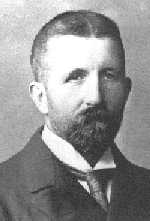
|
But
'Goulton Constable' was not his sur name at all .......
The Rev. Charles
Constable of Walcot
(1773-1852) got Walcot and Whitton from his mother Sarah Goulton and he
left an only child, Mary, who became Lady Strickland on her marriage to
Sir George Strickland, bart. On Lady Strickland's death in 1865, the
Walcot and Whitton estate was left to her daughter and son-in-law, Lucy
Henrietta Marriott (1822-1871) and the Rev. James Powell Marriott
(1819-1871), on condition that they assume the surname Goulton
Constable, which they did in 1866. At their deaths five years later,
they were succeeded in the estate by their third son, James Marriott
(1850-1922),
on the condition that he too assume the surname Goulton Constable,
which he did in 1872.
By November 1919 James
Goulton Constable
was 69 years old and (perhaps because of threats to nationalise land,
made by Lloyd George, in his 1909 budget.) had decided
to sell the estate.
The Whitton estate comprised a little more than 1350 acres - 'Four
compact mixed farms, a grass farm, small holdings, woodlands, grass
lands together with cottages and gardens'.
A table showing the 47 lots with their tenants before the sale, and the
area of each lot is shown (left). The price paid is shown in italics
together with the new owner, also
in italics , if
he or she is not the sitting tenant.
|
| |
Acres 1350. 3.
20
|
Total price paid
£ 46,433 |
|
REFS: This
writer's copy of
Particulars, Plan and Conditions of Sale; LAO:
10NOTT, (Acc.
2000/101) ; Burke's Landed
Gentry,
18th edn., vol.3, p. 613
|
| The
Motor Car arrives
in Whitton in the 1920s.
A
busy day on Main Street as a
group - probably Maurice and Isabella Bray and family - with black dog
stand outside the old Manor House and watch the cameraman.
Maurice Bray was a builder.
|
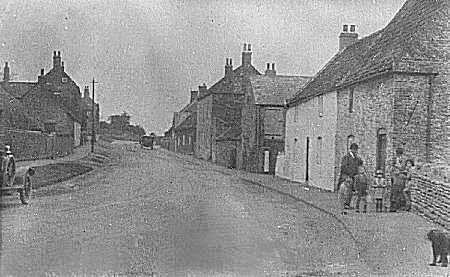 |
1920
Stone Heaps
and the Devil's Causeway 'The Stone Heaps lay
at the
bottom of the first cliff. These were blown up in the year 1920 by the
Humber Conservancy, because owing to the land having been washed away,
they were a distance into the water and were not visible to ships at
high tide.The cost of blowing them up was about £ 500 and the weight
about 1700 tons.
The Causeway is marked on all old maps and consists of flat squarish
lumps of stone or rock. it is not far from the old Stone Heaps and
crosses the river in an easterly direction. Mr Holgate Barley has told
me that when the tide is low, he has distinctly felt his small boat
catch the stones at various places across the river.' (ks)
Note: A purely natural geological
formation or a
Roman aid to crossing the river ?
As soon as the Roman army crossed the Humber in AD 71, a fort was
constructed at Brough, immediately across the river from Whitton . The
site was used throughout the Roman period, either as a military
settlement or as the civitas capital Petuaria
Parisorum.
It does seem at least possible that Whitton was a landing stage on the
south bank for this fort. However estuarine erosion is presumed to have
destroyed most of the archaeology on the Whitton foreshore, and we may
never know for certain. |
1920
Whitton Pier is demolished.
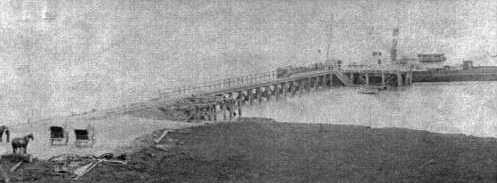 |
Whitton
Pier in its
heyday.
A
Steam Packet waits
to pick up passengers.
|
| The pier
at the end of its life. Smoke billows from the waiting room chimney.
The railway line buffers can be seen at bottom right. |
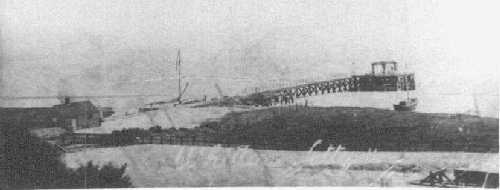
|
The
pier was done away
with in about the year 1920 owing partly to the moving of the channel
making it impossible for the boats to call and also because it was
getting unsafe. "(ks)
'The Gainsborough United Steam Packet Company Ltd.' owned the boats
which plied between Hull and Gainsborough from as early as 1814 to the
1930s.
Only the small pier waiting room remains - now in the garden of the
newly built 'Ellerker House'. |
When the Whitton jetty was demolished in about 1920, some of its smooth
stones were used by Maurice Bray in the building of this bungalow by
the river. It seemed, from a distance, like a fort erected to guard the
foreshore.
It was the home of the Brays and then the Burgess family and was
converted to a house in 2002. |
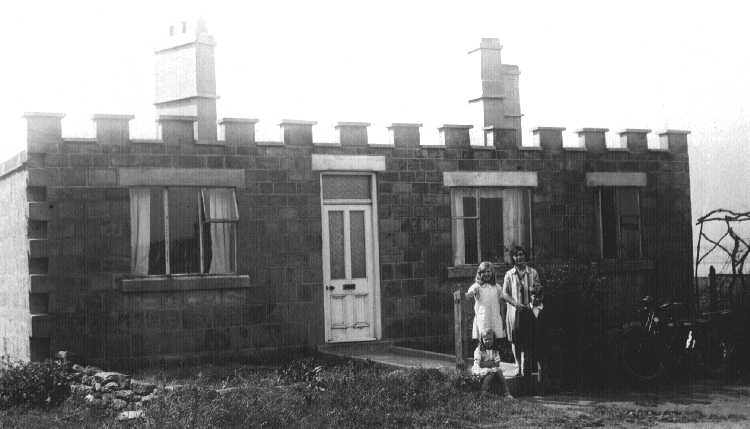 |
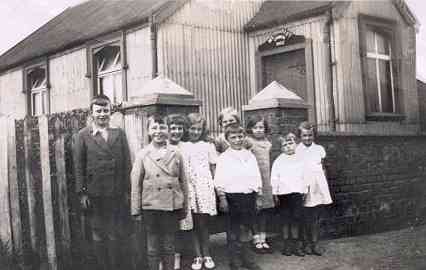 |
Left :
Whitton children outside the village's Primitive Methodist Chapel some
time in the 1930s. Opened in June 1905, it seated about fifty on
polished wood benches
The 'Tin Tabernacle' was on a small plot of land of about 940 sq yards
on Chapel Lane. It has since been pulled down and replaced with a
cottage.
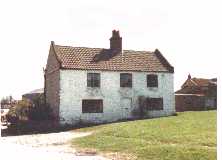 |
| The
Weslyan
Methodists had met in a room at the White House (right) for many years,
but combined with the Primitive Methodists in 1936. |
1921 Whitton Social and Sports Club. For a
time in the
1920s, during the period that William Vickers, landlord of the Blue
Bell Inn on High St. in Scunthorpe owned Humber View Farm,
there
was a Social and Sports Club in Whitton. In 1922 Harry Birkett was
listed as Secretary, and later it is believed that Frank Short
(1871-1931) was Steward. The Club was in a hut in the yard of Humber
View Farm and members could play cards and dominoes while enjoying a
glass of beer. It is not known when or why it closed. |
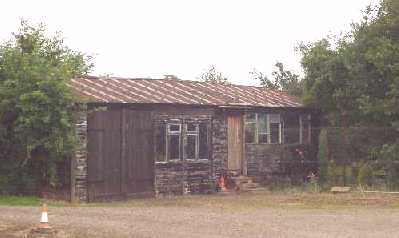
The Social and Sports Club in 2004....... |

1922
Train Timetable One
train a day to Whitton. This passenger service from Scunthorpe closed
three years later.
1922
James Goulton
Constable of Walcot Hall, died on the 1st
December aged
72. He had sold Whitton in 1919 for £ 46 thousand, but his will,
published in May 1923, revealed that he left only £ 3,778 - 13s -
10d. Hull
Daily Mail,
Monday 7 May 1923
1922
KELLY'S
DIRECTORY
BARLEY Holgate coal merchant
BELL Fred shopkeeper
BRAY Maurice overseer and rate collector
DOOK Charles farmer
NAYLOR Thomas cowkeeper & parish clerk
NELSON Frank farmer
SHORT Frank miller |
SPILMAN
Thomas L.
farmer
WADE George painter and decorator
WHITE Thomas blacksmith
WELLS William sub-postmaster
UNSWORTH Herbert stationmaster
ELLIS Lillian, Miss schoolmistress
|
A
sports and social
club was opened in 1921 with Mr Harry Birkett as secretary.
The church was restored in 1894 at a cost of £ 900 and in 1897 the tower
was also restored at a cost of £ 140. On the north side of the church a
stained glass window was erected in 1918 to the memory of Henry Spilman
who fell in the Great War.
A motor omnibus service, from and to, Scunthorpe serves the village
three times daily.
Note: 'Old Tommy' Naylor (1854-1940) is
remembered as
a tall white-haired, unsmiling man who rang the three church bells all
by himself, one bell rope in each hand and one looped rope, rung with
his right foot.... |
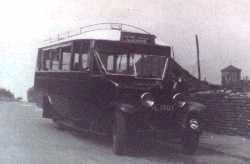
1923 'The
Whitton Flyer'. Starting
in 1923 this motor bus owned by Mr William Jarvill and Mr Charles
Vessey, travelled the route between Whitton and Scunthorpe, via Thealby
and Alkborough . |
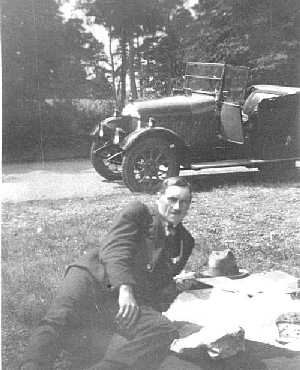 |
1925
The first
Private Car in Whitton ?
Whitton farmer Thomas L. Spilman enjoys a picnic
lunch
while posing proudly beside his new possession - a 'Bullnose' Morris
Oxford. Later in that year he toured as far away as Cambridge and
Norfolk enjoying the near deserted roads of the day..... |
1924
Lewis Robert
Goulton Constable gave
up his right to
alternately appoint the vicar of
Whitton (the advowson), since when the vicar has been appointed
exclusively
by the Bishop of Lincoln. Ref: London Gazette, 27
June 1924.
1929
The end of the Parish Constable.
As far back as 1872 the Parish Constables Act, had directed that the
election of parish constables was unnecessary, as an efficient police
force (the Lincolnshire Constabulary) had been established . Whitton
however, perhaps thinking that the 'bobby' on his bike at Winterton was
a long way away, continued to nominate, rather than
elect these
officials, as it had done for centuries - records of such elections, by
the Vestry Meeting, exist from 1609.
In February 1929 the Parish Meeting nominated Constables for the last
time; they were Sam Foster, George Short, T.L.Spilman and Stan Spink.
1930
KELLY'S
DIRECTORY
BELL Fred general dealer
BRAY Maurice builder
DOOK Charles farmer
FOSTER William farmer
GREY Charles farmer
NELSON Frank farmer
NAYLOR Thomas fmr and parish clerk
SHORT Frank miller
SPILMAN Thomas L. farmer
WADE George painter and decorator
PEACOCKE Rev Benjamin (Cliff House)
|
1933
KELLY'S
DIRECTORY
BELL Fred shopkeeper
BRADER William farmer
BRAY Maurice builder
DOOK Charles farmer
GREY Charles farmer
NAYLOR Thomas farmer
NELSON Frank farmer
SHORT Frank miller
SPILMAN Thomas L. farmer
WADE George painter and decorator
FORD Rev William (Cliff House)
|
1937
KELLY'S
DIRECTORY
DOOK Charles retired farmer (Cliff House)
BELL F.R. shopkeeper
BRAY Maurice builder
FISHER Fred farmer
KNAPTON T.N. farmer (The Grange)
NELSON Frank farmer
OGG BROS. farmers
SHORT Charles S. corn and flour dealer
SPILMAN Thomas L. farmer
WADE George painter and decorator
|
'In
Mr Dook's opinion
the two worst things to happen to agriculture were the operation of the
Agricultural Wages Board and the introduction of summer-time....'The
Hull Times 8 April 1933
Note: Charles Robert Dook ( 1866-1951 ) |
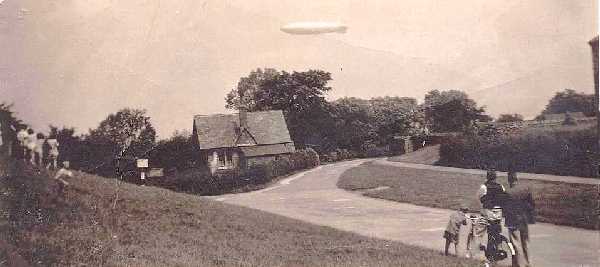 |
1936
July
The 'Hindenburg' over Whitton At 803 feet long and 135 feet
in
diameter, the German passenger airship 'Hindenburg' (LZ-129) was the
largest aircraft ever to fly. She was launched
in May
1936 and began the first of ten round trips from Friedrichshafen to the
Naval Air Station at Lakehurst, New Jersey. It was widely thought in
Whitton that the trips, which took it sometimes over Hull and
Liverpool, were clandestine Nazi spying missions. This peaceful rural
scene with the school and village children outside Cliff House
contrasts strongly with the sinister shape of the Nazi airship.
The 'Hindenburg' burst into flame coming into land at Lakehurst Naval
Air Station on 6th May 1937 killing 37 of the 91 passengers on board . Photo : Mary Parker née Thornton |
1937
Holgate Barley (1850-1939) plants a tree
( the one opposite Cliff
House) to commemorate the Coronation of George VI on 12 May 1937. .
Always
dressed in a peaked cap, a man which cannot fail to
impress....to stop for a word is to step over the threshold of 80 years
of rural life. His father John Barley was the light keeper on the river
bank when they were the only guide to navigation.There were 6 children
in the family but it became the lot of Holgate to assist his father,
first in the coal business and later to take up the lighting and
surveying. Eventually a lightship was placed in the Humber and he was
one of the first to assist in keeping it. Later
with the growth of the packet service between Hull and Gainborough a
pier was constructed and Holgate saw it built, rented it and was pier
master for 20 years until it ceased to be a paying concern and was
pulled down. A widower for over 30 years, he has 12 children.-The
Hull Times 8 April 1933
|
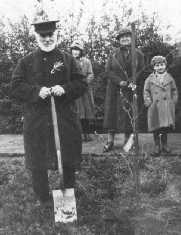
|
| Note:
At one
time, on the foreshore at Whitton, there used to be a strange
railway-like construction. Narrow gauge lines, along the shore, carried
a wooden structure on bogie wheels with a navigation light on top. As
the navigable channel and the sand banks in the Humber changed, the
light structure was moved along the track giving boats a more accurate
warning of the danger of grounding. |
1938
The end of the Cargraver
Along with Parish Constables and Overseers , the Parish Meeting had,
for generations, elected a cargraver (or cargreave or cargrave). This
was an official who looked after the Carr Drain and the Marsh Drain and
the sluice gate ( which in Whitton is called the 'cleugh', pronounced
'clew') . The last cargraver, Fred Fisher seems to have been elected in
1938 but by 1943 the duties of the cargarver had been taken over by
the River Ancholme and Winterton Beck Catchment Board.
1938
Air Raid Precautions In
February Brigg Rural District Council asked the village to nominate a
Decontamination Post and a First Aid Post in Whitton, which could be
used in the event of a gas attack. They also asked for a list of
private cars which could be requisitioned in the event of enemy action.
The Parish Meeting, on Monday 21st Feb, suggested the School and Church
respectively and advised Brigg RDC that Whitton's four motor vehicles
belonged to Norman Knapton, T.L. Spilman, Stanley Spink and George
Wade..
1939
Whitton at War
"Ten
territorials from Gainsborough came and took over the top part of the
Cliff. They brought a search light and later on an anti-aircraft gun
arrived. The site is now taken over as a permanency by the War Office.
On Sept 3rd the evacuees arrived from Hull. Whitton took in five boys,
five girls a teacher and a helper. By Xmas only six remained'. (ks) ( The
children came from the Wheeler Street School, Hull , HU3
5QE.
)
September 12th Evening Church Services moved to 3pm owing to war. If
windows could be 'blacked out' services could again be held in the
evening.
October 8th 'Black-outs' installed. Evening Services at 6.30 again.
Senior A.R.P warden Mr F.F.Fisher checked to see that 'black-outs' in
accordance with regulations.
'In October 1939, when war had been on a few weeks, the railway line
between Winteringham and Whitton was taken over by the Government.
There were about 100 trucks all sealed and supposed to contain
ammunition and mines . They were guarded night and day by 20 naval men.
My husband in order to cross the railway line to shepherd, had to show
a pass otherwise he was liable to arrest.
The First Aid Post was set up in Bullivant's old cottage "(ks)
October 11th 'Distribution of gas-masks to children this afternoon
before 'home-time'. '
October 17th Air Raid Practice - school practises dismissing children
quickly in groups, in case of air raids. All children could get home in
2½ to 3 minutes.
October 25th "We are just noticing (after very little navigation on the
Humber lately ) that some of the passing ships are now carrying guns."
- Miss Ellis, schoolmistress.
Notes:
Circular depressions, where the anti-aircraft gun,
searchlight
and a 'big ear' listening device were placed during the war, can still
be clearly seen in the grass on the Cliff Top. ( The rectangular piece
of concrete nearby is, however, the base of the old Whitton Cricket
Club practice net.) About ten regular soldiers, under a Sgt.
Entwhistle, lived in tents for about two years, manning the Unit. There
was a field kitchen in a hut, first under the trees between the school
and the Old Vicarage and then on the Cliff itself, nearer the Unit. The
men were sometimes able to get a hot bath, have their clothes washed
and enjoy a warm meal at Sam and Annie Foster's house.
A large dry circular pit 30 yards to the south west of these three
depressions on the Cliff Top, often referred to by ks as the 'dew
pond', was probably dug long ago to provide a constant source of
drinking water for cattle in the Cliff Field. In frosty weather the ice
which formed on the pond was sometimes thick enough to support skating
children. It has in the last 30 years, been largely filled in with soil
and straw.
Frederick F. Fisher, the Air Raid Warden, lived at 'Humber View Farm'
and moved to Roxby in 1945.
Bullivant's old cottage was at the corner of Chapel Lane
and Post
Office Lane.
1940
In
January, Whitton shop began to ration bacon, butter and sugar. This was
soon followed by meat, fish, tea, jam, biscuits, breakfast cereals,
cheese, eggs, milk and canned fruit.
Food shortgages would be a problem throughout the war , but the fact
that many village people had large vegetable gardens made the
situation, perhaps more tolerable for them, than those living in towns.
There was the occasional treat; an oft-told tale recalls how Sam Foster
shot a swan which had unwisely flown over his garden. His wife Annie
promptly roasted it, although it barely fitted in the AGA, and the
family had a splendid feast that evening. Realising that the swan is a
protected bird (and theoretically belonged to the King) , Annie made a
present of, what she called, a nice 'goose' sandwich when the local
policeman called in on his rounds later that evening.
Jan
24th
Because of the intense cold, the radiators in the church froze and the
boiler burst .
Jan 30th "The snowy weather
which started about
the 10th of this month and has continued without one thaw, has at last
turned Whitton into a completely isolated village. No one has been able
to get in or out of the village - 40 men have been at work digging out
the road to Bishopthorpe which in some places is 4ft deep and 2 to 3 ft
practically the whole length. There is a great shortage of coal,
paraffin and bread - no yeast.
The soldiers on the Cliff had emergency rations brought through late in
the evening by horse and cart. The Humber is a mass of ice, great lumps
being wedged together. The Trent is so frozen that 7 men and 7 women
walked over from one side to another. At High Risby the drift is 9 to
10ft high. Such weather has not been known within the memory of living
man.
The birds are dying and even the poachers and duck shooters have
stopped going out as they say it is simply murder - the wood pigeons
are eating the greens in the village gardens. |
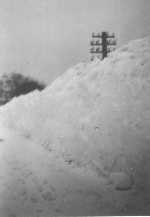
Snowdrifts on Whitton Road
|
Numerous
people and cars have been dug
out of snow drifts. The Wells family have had the Post Office for very
many years and they say that for 46 years until Jan 30th 1940 there has
never been a day when the letters missed coming into Whitton". (ks) The
Army was of course on hand to dig the village out. Soldiers from
Whitton and West Halton started from their respective villages and met
in the middle.
Note:The winter of 1939/40 was the coldest since
1894, but
wartime censorship prevented this being made public.
Feb 16th 'Ronald Whitehead (evacuee) returned to
Hull this
afternoon. He has been staying at Mrs Burgess's, at the
Humber Side Bungalow.'
June 21st Very bad air raids lately ....children
having very
'broken' nights. There was a very bad one on the 19th when parents and
children were up most of the night.
June 26th Because of the disturbed nights through
air raids,
the school to be opened at 10 o'clock in the mornings until further
notice. As it is very bad just now, this time to commence tomorrow.
June 27th Very bad air raid - thankful for extra
hour off -
150 incendiary bombs dropped at Scunthorpe.' - Miss Lillian
Ellis.
August 26th The Bishop wrote to Whitton
Parochial Church
Council ordering that all the church plate and the Registers should be
buried either in the church wall or in the floor of the church in case
of invasion. The Council decided that the chalice, paten and flagon '
be enclosed in a certain spot and that a plan of the spot be kept by
the Vicar and a copy sent to the Bishop.' The 'certain spot '
was a small hole dug between the altar and the east wall and covered by
four floor tiles (which are still loose) . The Registers were left in
the Church safe.
October 8th - 'Reopened school after holiday.
Only one
evacuee left. Ronald Howland is the little Hull lad and he is very
happy at Mrs Spilman's ' - Miss Lillian Ellis.
He left Grove Farm and returned to his parents, in May 1941 and there
were no more evacuees in Whitton.
The
Home Guard in Whitton. With
the German invasion a very serious threat, 'The Local Defence
Volunteers' (LDV) was formed on 14th May 1940 but the name was changed
in July 1940 to the more inspiring 'Home Guard'. The Section Commander
for the village was Sgt Alec Spilman (1894-1950) and the Platoon
Commander for Alkborough, West Halton, Winteringham as well as Whitton,
was Capt. Arnold Drinkall M.M. (1897-1971), who was an Alkboro'
undertaker and joiner. Both men were WW1 veterans. The Whitton Section
consisted af about ten men who were in reserved occupations like
farming or steelworking and so could not serve in the regular army. The
Whitton Section occasionally drilled in the school, but were mostly in
evidence each night as a two man guard occupying a lambing shed which
had been towed to a piece of grass at Whitton Lane end. In case of
invasion, rifles and grenades were kept in a small brick lock-up (now
gone) in the garden of North Cottage on Main Street.
By 1943 with fears of invasion faded and with the Germans seemingly on
their way to defeat, absenteeism nationally began to be a problem.The
Home Guard stand-down was on 3rd December 1944, and it was disbanded on
31st December 1945.
 |
Small
magazine .303
Lee Enfield Rifles were issued to the Home Guard |
1941'...many
will remember the
time when burnt debris floated down with the tide, after the awful
night when Hull had been seen from Whitton, a mass of flames burning,
the result of the German incendiary bombs..' (ks)
Note : ks is remembering the 7th May 1941 when
the Luftwaffe
launched the first of two massive consecutive night raids against the
port of Hull and the anti-aircraft gun in Whitton Cliff field was at
its busiest. Later in the same week the House of Commons and
Westminster Abbey were bombed.
27th
October. Miss Ellis Retires
Lillian Ellis taught the children of Whitton from 1913 until 27th
October 1941 when she retired, and the school's final teacher, Mrs
Kathleen Tomlinson from Thealby took charge..
When a teacher, Miss Ellis cycled to and from Whitton School to
Winteringham
along the side of the railway track. In bad weather she would stay
overnight in Whitton (sometimes with the Dooks or the Barleys and later
with Miss Gwen Bullivant). On her last day, after 28 years at Whitton
School, she wrote in the School Log, ' Goodbye little ones'.
Lilian Ellis was born in Hull in 1877 and lodged in Winteringham (with
Miss Viner on Back Lane) where she continued to live and play the
church organ after retiring from teaching, and where she died in
November 1948 aged 71.
1943
Whitton school
bell rings for the last time Jan 8th 'Letter
received
today from Mr Bray stating that the school is to be closed for the
duration of the War. The children and myself to go to Alkboro. This is
owing to the serious shortage of teachers in Lindsey at present'.
Feb 17th 'School children to be transferred as soon as Alkboro' canteen
is working '.
March 17th 'Whitton school closed today.' - Mrs K Tomlinson,
schoolmistress
Note: The school did not reopen...
(
Right: photo of the
old Whitton school bell, courtesy of Claire Birkett )
|
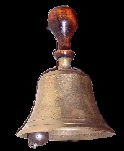 |
| 1944
March
25th. The Parochial Church Council bought, for £ 30, a piece of land at
the south west corner of the churchyard in order to extend it. The land
had belonged to the executors of a Miss Bentham and the Council had
been willing to pay as much as £ 35 for it... |
 |
The
new, additional,
triangular piece of land, made the churchyard into more of a
rectangular shape.
The line of the old boundary can still be seen in the grass of the
churchyard today.
Left :the piece of ground that was added. |
1945
Victory in Europe At their
regular meeting on 19th April the
Parochial Church Council made
tentative arrangements for a Thanksgiving Service at
10 am on
'Victory in Europe Day'..... whenever that happy day should
be.
In the event, it was held less than three weeks later - in Whitton
church at 6.30 in the evening of V.E. Day - Tuesday, 8th May
1945...
'A fund for
the boys on their homecoming provided about £ 4 per head . It was
decided that the share of those that did not return was to go to start
a village war memorial, but owing to some people disliking the idea,
the money was given to the next of kin and so no memorial was erected
in the village. The Mothers' Union raised money for a shelf to hold
flowers under the plaque in the Church.
During this war 30
people were on the list
as helping in some way - Army, Navy, Air Force, ATS and Land Army.
Three never returned - Robert Bray killed in Italy, Percy Foster killed
at Tobruk and Thomas Levick Noel Spilman killed in Italy. These
three boys' names are on the plaque in the Church under the names of
the three killed in the 1914-18 War.
When peace was
declared a stack of old
straw was set alight at the top of Backsides . Owing to the
unsatisfactory state of the world, no celebrations were held....' (ks)
Notes:
Pvt Robert John Bray 5th Bn., Sherwood Foresters died Sat, 8th January
1944 Age 19. Cassino, Italy
Able Seaman William Percival Foster, H.M.S. Martin died Tue 10th
November
1942 Age 23. off Tobruk, Libya
Son
of Samuel and Annie Foster
Cpl
Thos L. N. Spilman 27th Lancers,
Royal Armoured Corps, died Monday 23rd October 1944 Age 21. Forli, Italy
Nephew
of Henry Spilman killed in
the Great War............. and the only son of Kate Spilman
(ks).
'Backsides' is the grass field, immediately behind the houses and
gardens, on the west side of Main St.
Whitton did
get its
celebration, in the form of an August Bank Holiday fête on the Cliff
Top and although the Sports were curtailed by the cold windy weather
and both the Opening Ceremony and Fancy Dress Parade had to be held in
the old school , the sum of £ 26-14-6 ( £ 26.72½ ) was raised. The
village was thus able to send its children on a day trip to Cleethorpes
on a budget of 7/6 ( 37½p ) per child. This seaside visit was on
Wednesday, 29th August 1945.
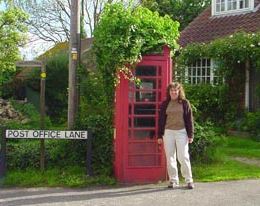
|
1949
Whitton got its own telephone box.
From the mid 1930s the public telephone had been in the Post
Office , that is in Miss Wells' front room, where she would answer
calls with the words, "Whitton One! Attendant speaking."
Villagers who went to her front room to make a call were understandably
unhappy about the lack of privacy and there were continual requests for
the GPO to make more suitable arrangements. These were not answered
till 1949, and the kiosk that the GPO installed has been in its present
position since that time. The kiosk has now lost
its
phone and serves as an information box
LEFT: An American tourist, with Whitton ancestry, has her photograph
taken next to the
former village telephone box.
|
Whitton's
General
Store
Whitton's best remembered shop was on Main Street and
stood
opposite the end of Post Office Lane. (right )
For very many years the shop was run by the Bells. Mrs Emma Bell (
1841-1910) was the first of the family and then her son Fred (
1874-1939) took over and combined running the general store with a
shoemaker's shop. Fred's sister Harriet Bell (born 1877) went to live
at the shop, in about 1922, after Fred's wife died (soon after their
youngest child was born). After Fred himself died in 1939, Harriet
carried on running the shop for a while with the help of Fred's
daughter 'Hetty'
It was little larger than a small box room but sold a surprising range
of items - tinned foods, cigarettes, newspapers (brought out to Whitton
on the 8 o'clock bus), sweets in big glass jars and lots of other
things.... Paraffin was sold from a big tank in the little end building
that had been the shoemaker's shop (left of photo). At Christmas the
shop window was full of toys....
When the Bell family gave up the shop it was bought by Mr Drinkall and
run by Mrs Norah Kirkby ( 1914-1999). It has now been converted into a
private house called 'The Old Post Office', which it was for a while in
the 1970s . |
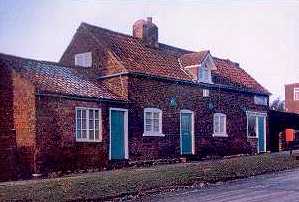
In the late part of the 19th century there were also two other very
small shops in Whitton - both in Post Office Lane. One was in the
cottage on the corner opposite the Chapel and the other on the opposite
side of the road The directories show Harriet Morwood (1820-1901) and
Grace Walker having shops at this time.
For a while in the 1960s 'pop' and crisps and choc bars were sold by
Stan and Phyllis Short from their cottage on Old Mill Lane. |
1951
October
The West Halton to Whitton section of the North Lindsey Light Railway
finally closed to all traffic on 11th October. Whitton
station remained derelict for many years and a visitor in 1952 noted '
....its windows devoid of glass staring at the turbulent river . The
weed choked lines which run before its cracked single platform and halt
at the weighing office are hidden by the undergrowth.The waiting room
door, swinging crazily on broken hinges, bears the chalked legend - No
trains today".
All traces of the Railway Station have now been removed and new houses
are being built where it stood. |
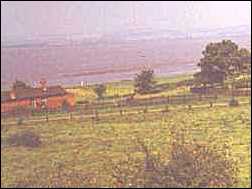
Derelict Whitton station stares across the river to Yorkshire.
|
| In
1954 a suggestion
from the Parish Meeting that the County Council should take over the
disused railway line, and make out of it a 'direct highway' to
Winteringham was rejected . |
1951
November Surnames on the
Whitton Register of Electors, qualifying date 20th November 1951
- Barley; Bell; Birkett; Blanchard; Bower; Bray; Breeton; Buffham;
Bullivant; Burgess; Chapman; Cook; Coultard; Cowling; Curtis; Danson;
Dawson; Dook; Everatt; Foster; Hawksworth; Hewitt; Hill; Howlett;
Hughes; Hollier; Kennett; King; Knapton; Langton; Loftus; Ogg; Panton;
Porkess; Roberts; Rudkin; Shaw; Short; Spilman; Spink;
Standerline;Thomas; Thornton; Vessey; Waddingham; Wade; Webb; Wells;
Williamson; Wright; Yorke.
Fifty-one surnames and 125 electors - see complete list as
Appendix 6, below. Of these names only Bell, Thomas and
Thornton
appear in the 1642 list and are not, of course, necessarily related at
all.
1952
March The County Council
told the Parish Meeting that their earlier request that Whitton should
elect a Parish Council might be approved, although
the
village's population was only 168. The Meeting reconsidered their
request and since interest in village affairs was low, decided against
pursuing the matter.
| Old
Mill Lane For most of recorded history the little Whitton
thoroughfare known as 'Old Mill Lane' was called 'The End' . There were
a few old cottages on either side of the lane and towards the bottom,
the White House with the little Weslyan Chapel adjoining it. Opposite
the Chapel and the White House were a pair of cottages where two miller
brothers called Stan and George Short carried on a business started by
their father Frank (1871-1931) . Mr Stan Short had a milling machine in
his yard and used a lorry to deliver corn and flour to customers in
Whitton and surrounding villages. This business gave its name to 'Old
Mill Lane' because sometime in the 1950s the name of the lane changed
and that was the end of 'The End'. |
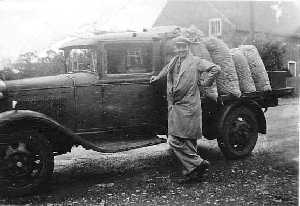
Stan Short (1901-70),
the miller of Old
Mill Lane
|
1953 June 2nd "The
coronation of Elizabeth II. Sports were held and seats were placed in
places in the village. It was a wet day and so the sports had to be
curtailed. Many watched the service from Westminster Abbey on their
television sets. Every house received a souvenir - a tin of tea. " (ks)
...and every child received
a coronation mug.
Note:
It is very unlikely
that anyone in Whitton watched the ceremony on
television
because of the absence of mains electricity in the village at the time.
Whitton children are presented
with their
Coronation Mugs, Tuesday 2nd June 1953
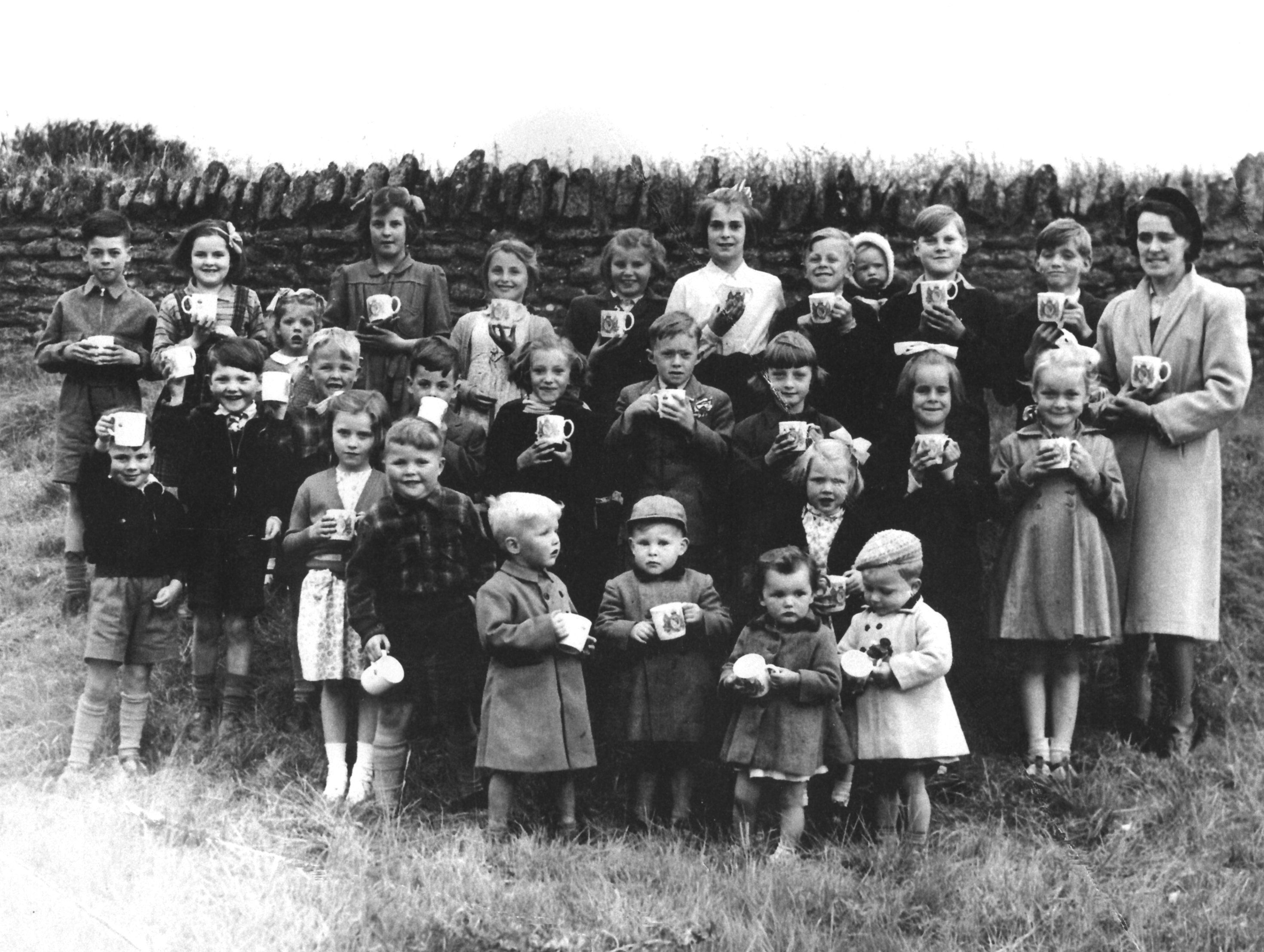
Photo
: courtesy of Michael Bray.
|
|
Back Row: left to right
Lesley
Thornton : Elizabeth Thornton : Jaqueline Thornton : Pat Buffham :
Margaret Buffham : Josie Hawksworth : Pauline Kennet : David Knapton :
Janet Thornton : Stuart Webb : Malcolm Kirkby : Mrs Kennet
Middle Row: left to right
Keith
Thornton : Michael Bray : David Wright : Michael Thornton : Pauline
Hawksworth : Tony Langton : Jane Webb : Diana Knapton : Marion Kennet
Front Row: left to right
Maureen
Bower : Phillip Wright : Anne Bray
Little
Ones:
left to right
John Wright
: Peter Breeton : Sheila Bray : Stephen Cowling
|
 |
|
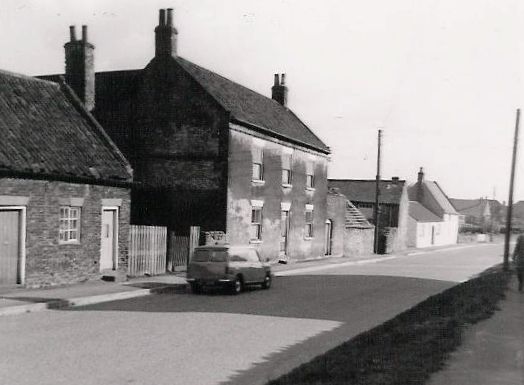 |
Left:
sometime in the
1950s.....
a
bus of the Lincolnshire Road Car Co. in green and cream livery (perhaps
a Roe bodied Leyland Tiger TS8 ) waits opposite the shop on
Main St, Whitton to leave for Scunthorpe. For many years Mr Fred Firth
and Mr Billy Foster were the bus-drivers. |
|
Right:
buildings, which have since disappeared, between Village Farm and the
white painted Manor House are seen in this photograph from 1966.
|
1953 Sunday July 19th 'The
church was open for services again after being closed for repairs for
many weeks. A different arrangement for the fall of the water from the
roof has been made, the old gutterings having been removed; they were
worn out....the crack in the tower has been mended and the stones
pointed up and made safe. The loft has been cleaned out. Cracks in
other parts of the church have been repaired and the stonework of the
windows attended to. The tiles in the chancel have been reset and the
whole of the inside (of the church) has been cream
washed. The
names on the Roll of Honour are being regilded. Electric light has been
fitted.' - (ks)
Notes: The electric lights could not be
turned on for
another seven weeks as cables were still being strung across the fields
and had not reached the village.
The tower was repaired at the expense of ks and her husband in memory
of their son killed in the War and a brass plate commemorating this,
was dedicated by Rev Summers on Aug 8th 1954.
Right:
Staring
at the camera from the scaffolding
surrounding the roof of Whitton church in the spring of 1953 -
from left, John Spilman,
Harry Spink, Jack
Langton and Bernard Ogg.
|

|

Yorkshire
Post 28
Aug 53
|
1953 Thursday August 27th "Lord
Noel-Buxton walked across the Humber. He used a boat for the
dredged channel on the Brough side. He left Brough at 3.10 and arrived
at Whitton here at 4.36pm There were about 500 to see him leave Brough
and
the same to see him arrive. He landed in the Marsh where the helicopter
which had been following him landed to welcome him. Many of the
sightseers were in a far muddier condition than Lord Noel-Buxton as
owing to the high tides the foreshore was muddy and slippery. ... he
walked it very easily with a pause of 1/4 hour or
so on the far side of the water. This side was bare sand and mud, but
within 1/2 hour there was deep water all over the part he had walked. I
found later that the Humber had been walked by four Ferriby men about
15 years ago." (ks)
"The crossing was unexpectedly easy," said Lord Noel-Buxton afterwards.
" At no point was the water above my waist, and at many places on the
sandbanks it was little more than ankle-deep".
Note:
Rufus Alexander
Buxton (1917-1980), 6'3" 2nd Baron
Noel-Buxton. In the previous year 1952, he had 'walked at low
tide across the river bed just
here ( Houses of
Parliament )
without getting his head wet, to the
general admiration of his fellow parliamentarians assembled on the
Terrace, in order to prove that there had once been a ford.'- Hansard
30 Oct
1997 : Column 1202
|
1953
Mains
electricity in Whitton "
Sunday, September 11th The electric lights in the Church were switched
on for evening service. The street lights had been on for about a
fortnight ".(ks)
A few days later mains electricity began to be supplied to Whitton
houses by the Yorkshire Electricity Board. The noisy petrol generators,
which had supplied some homes with power, fell silent and paraffin
lamps began to be replaced with light bulbs.. |
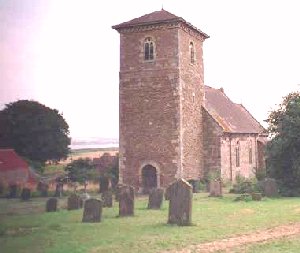
|
| 1955
How Whitton looked from the
air in the mid-fifties.... |
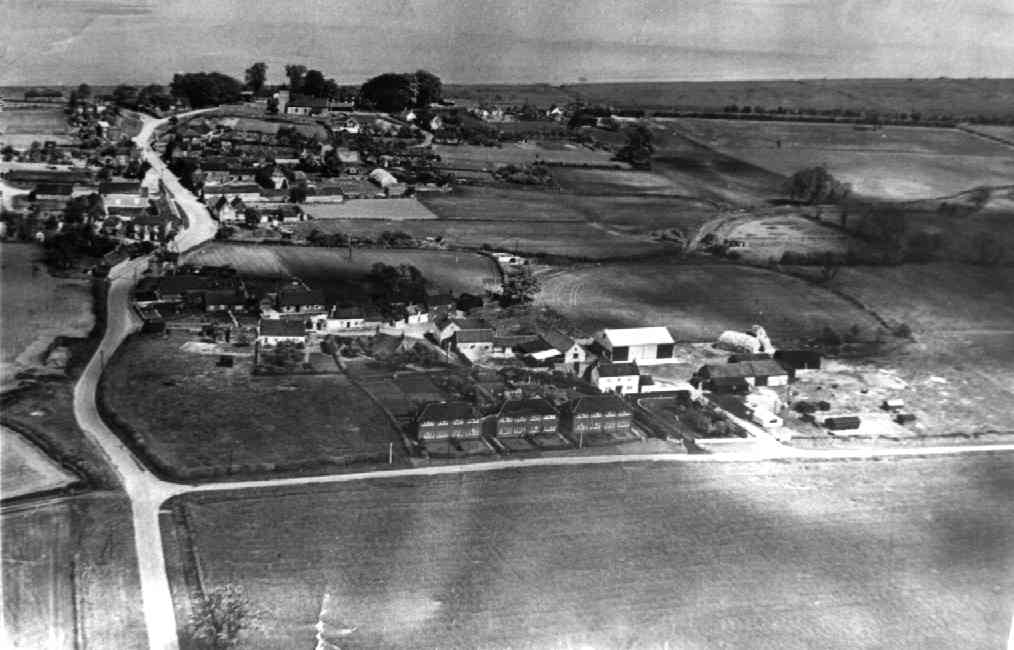 |
ABOVE:
Looking north
with
the Humber in the background. Main Street winds through the village
with Ings Lane and its six newly built council houses to the lower
right. The
Mill stood in the field at the bottom left hand corner. Mill Field Lane
can just be seen at lower left of Main Street and just above it north
of a small white circle is the ruin of the Blacksmith's shop. The
Church is seen at the top of the photo just below the gap in the trees.
BELOW: Grove Farm with its tennis lawn, stack-yard and crew-yard, and
across Main Street the white-fronted, old Manor House.
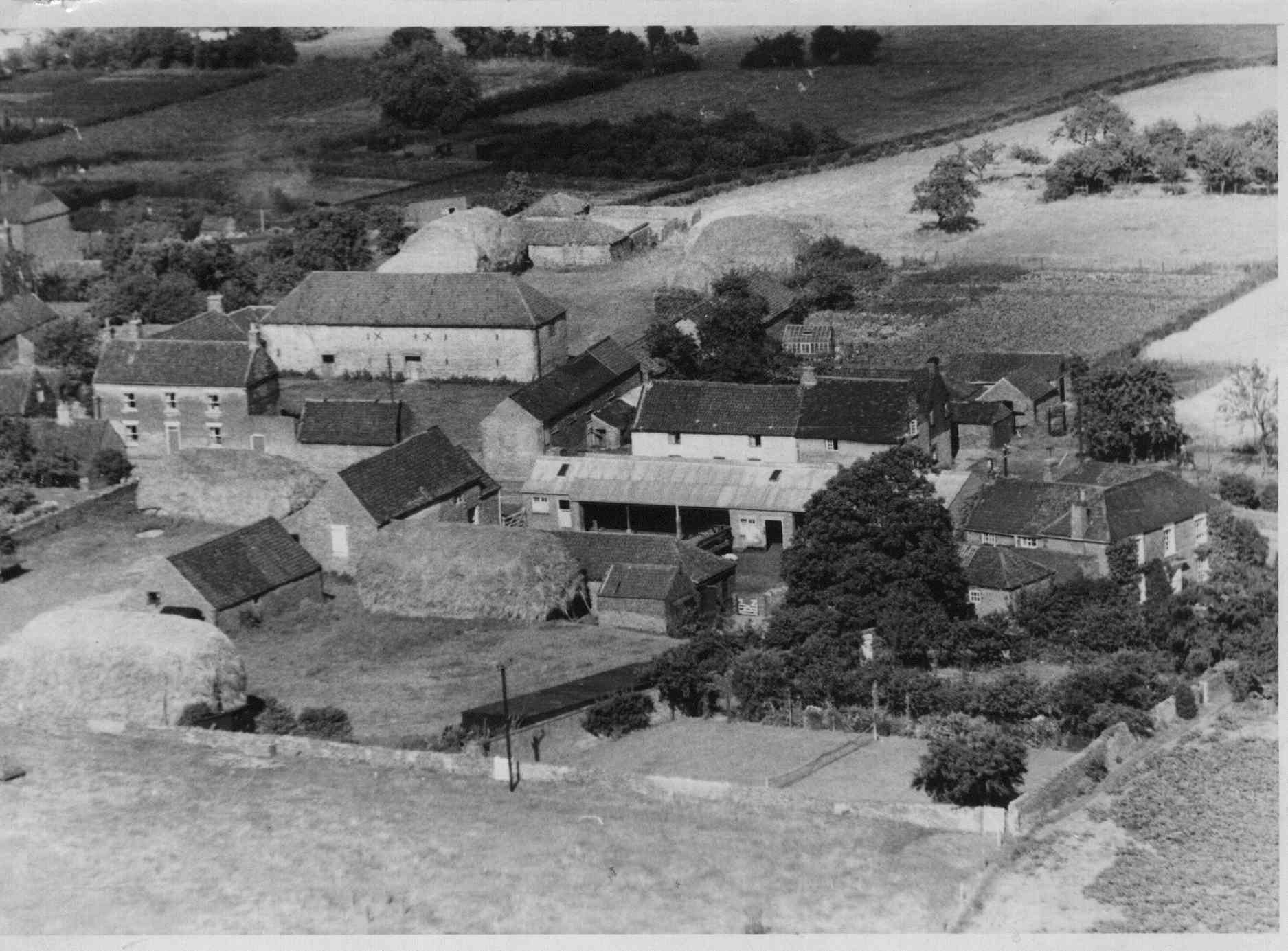
|
APPENDICES
1.
Rumours and myths in
Whitton's history.
a) 'Turner
painted most of his sunsets from Whitton Cliff top
when he stayed at Walcot Hall.' - J M W Turner had a Lincs.
girlfriend and patrons in Lord Yarborough and Col. Sibthorpe and his
watercolours of Lincoln, Stamford and Boston are well known. There is
no record, however, of a visit to this corner of the county.
b)
'King John's
treasure buried under tree on West Halton Road in
Whitton parish.'- He died on 19 Oct 1216 at Newark having
lost
jewels and money the day before while crossing the Wash. The treasure
was not recovered officially, so seems to be rumoured hidden in all
sorts of places.
c)
'Kirke White carved
'Oft in danger,oft in woe' on a tree in
Marsh field' - A curious assertion, and it seems
more likely that the young Nottingham poet used a notebook to record
his work while staying at Winteringham vicarage.
d).
'Ghostly black dog'
- stories of black dogs which run
alongside cyclists and then disappear are not unknown in the area.
e).
'You can see York
Minster from Whitton' - Yes,
it is
possible to see, with even a small pair of
binoculars, the east end of the Minster, 24 miles away,
from a position near the
stile by
Ashes plantation.
f).
"Whathams" and
Saint Etheldreda - According to the Liber
Eliensis about the year 672,
St.Etheldreda, left her husband
King Egfrith of Northumbria to return to Ely in Cambridgeshire. On the
way south she is supposed to have crossed the River Humber at
Wintringham and then, to have interrupted her journey and stayed on an
island in a fen at a place called 'Alfham'. Whilst at Alfham she
founded a monastery, before restarting the trip to Ely. This monastery
site is usually linked to Whitton’s neighbour West Halton where the
church is dedicated to St. Etheldreda, but West Halton church does not
look like an island site as described in the Liber Eliensis.
It is perhaps too fanciful to think that Alfham might instead be
associated with
the five old enclosures of Whitton called "Whathams". These lie above
the five metre contour line just to the east of the modern village and
would have been dry and above the marsh before medieval land
reclamation. An old lane, clearly visible on the aerial photos, peters
out as it nears the start of these enclosures. Perhaps beneath the soil
of Whitton parish are the postholes and remains of a wooden monastery
building founded by a saint….
However David Roffe, a former research fellow at
the
University of Sheffield, in a paper 'St Æthelthryth and the Monastery
of Alftham' has identified the monastery of St.Etheldreda (or St
Æthelthryth) with the deserted village of North Conesby, in Flixborough
parish.
Also Prof Cameron in 'The Place Names of Lincs ' Part 6 derived
'Whathams' from an old word for 'wheat'.
2. 'The
Whitton Flyer' - a poem by Alwyn. J. Barley in tribute to bus
driver Fred Firth
You can
have your veteran rally on that,
famous " Brighton run ",
Just give me one very dear old friend that gave us lots of fun,
Remembering that old passenger bus of grand and great renown
That gave we rustic populace an exciting ride to town.
A member of the " Lily " fleet, F.W. 40 was her name
And on the Scunthorpe-Whitton run she won her place in fame.
A tough old gal in every way of that there was no doubt,
With engine so reliant she put the rest to rout.
Some
drivers would abuse her with harsh
and clashing gear,
But one I know he loved her and always held her dear.
With touch so slick and skillful and possessive in every way.
A knight complete with charger, gallant, astute, and gay
This grand machine a " Flyer " so formidable and sure
Was " carrier cart " to market, a conveyance so secure
Many an " Irish Paddy " with pockets filled with gold
Was full of praise and laughter as the old bus pitched and rolled.
Returning
after trip to town for " Mass "
and then " Blue Bell ",
F.W. 40 was their " Saviour St. Patrick ", Pope as well.
The school kids just adored for that ladder on the back
Which meant a cheap ride out the village and then a long walk back.
This bus was temperamental on brake, " declutch " and " start ",
And a time I still remember she just would not depart.
Our driver quite resourceful. his face all wet with sweat
Turned and swung the handle but trying not to fret.
Another
driver came to his rescue whom we
all knew as " Fred "
He came upon the scene after cruel words were said.
He walked up to the bonnet with an endearing word and pat,
Then grabbed the starting handle just grinning like a cat.
I heard him mutter " Come on, Lass " the only words he spoke,
And with touch of so long standing he gave a little " choke ".
He swung the handle only once and the engine came to life
He turned and said quite coolly " Just treat her like your wife.
Always
treat her gently this classy
`Chevrolet'
She likes a little coaxing just like a little pet ".
Our driver looked astounded. his face all red then pale.
As the engine sang in unison right up and down the scale.
The driver then admitted as he gave a rueful grin.
"The old girl just had me well beat, I knew I couldn't win ".
And so on and on our hero went on her tough and rugged route.
Admired by young and old alike. she really was quite cute.
And to
"Fred", our astute driver, she was
a " Queen " with every load,
But he became a legend and a " Knight " of Whitton Road.
3.Whitton
School in
the early 1930s - a memoir
by Jessie Grant née Burgess.
'Up until about 1930/31 the children attended until school leaving age
(14 yrs). After that time, they left at 11 and went to Alkborough
school until they were 14. The teachers were Miss Ellis (aged about 60)
who taught the older children and Miss Marion Barley 1906-1998
(who had been a pupil teacher at Whitton school) who taught the
infants. There were about 25 children, all taught in the same
classroom. The school day was 9 to 12 and 1.30 to 4. The children went
home for dinner. During the summer many lessons were done outside under
the trees. The playground was the old school plantation – a lovely
wild, wooded area. |
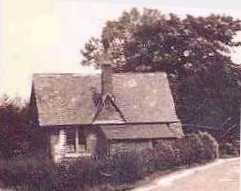
Whitton School in 1936
seen from the South
|
| Lessons
centred round
reading, writing and arithmetic with some history and geography There
were visits from the dentist. At Christmas a party was held with
presents for the children. Events held in the School -The school was
also used as the village hall. Concerts, which included songs,
monologues, etc., were given by the police (which I think were quite
hilarious.There were also slide shows, whist drives and dances. A
Christmas party, with games, was given each year for the whole village.
Mrs. Ford (the parson's wife) organised pantomimes put on by the Sunday
School children' |
4.Whitton's
three
Listed Buildings.
The older a building is, the more likely it is to be listed by English
Heritage. All buildings built before 1700 which survive in anything
like their original condition are listed, as are
many built
between 1700 and 1840.
The best are called Grade One (I) listed buildings. these are
'buildings of exceptional interest'. In Lincolnshire about 5% are Grade
I. There are no such buildings in Whitton.
The next best are called Grade Two Star (II*), these are 'particularly
important buildings of more than special interest'. In Lincs 7% of
listed buildings are Grade II*. a)The Church
is graded
II*
The
rest are
called Grade Two (II), these are 'buildings of special interest, which
warrant every effort being made to preserve them'. In Lincs 88% - are
Grade II. Both the Old Vicarage and Grove Farm are listed Grade II :-
b)The Old Vicarage
(right) because it is
late C.18th or early C.19th and is an example of a particular group of
buildings - vicarages. |
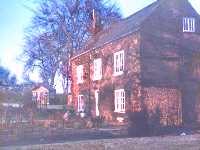 |
|
| c)
The Grove because it has C.18th or earlier origins,
although
much altered. It was raised and re-fronted in the later C.18th and the
front was again altered and a rear extension added to accommodate the
increasing family of Thomas Spilman (1809-1888) which had moved from
the White House in 1853.
Right
- The Grove in 1925
shortly after a large tree had been removed from the front garden so
that the flowerbeds, lined with box, (which still survive ) could be
established.
|
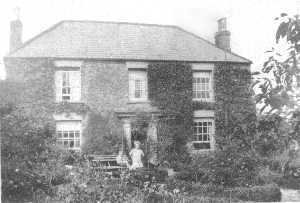 |
| 5.
A Flood in
Whitton ? Yes, that
was on Sunday 6th June 1982. See more of Fran Ross' photos of the
inundation here |

|
6. A vivid memoir of
the 1974 Flixborough explosion by John Wright of Whitton
' At
around 5pm on Saturday, June 1,
1974, I was sitting round the teatable at 3 Ings Lane having tea with
mum, dad and my brothers. I was a sub-editor in Hull in those days but
had come over on the New Holland ferry the previous day to spend the
weekend with the family. As we ate and chatted, the kettle stopped
singing. My mother said: "I thought I asked you to put the kettle on?"
to one of us. At that point, the electrical sub-station next to the
Flixborough caprolactam plant had been vapourised by the explosion,
killing the supply. A huge shockwave was, at that moment, sweeping
around the coast to Whitton. "I did put it on and it was singing", said
one of us and as we all looked at the offending kettle there was a
mighty crash and one of the windows in the kitchen fractured.
We shot up and looked over the field to where a huge plume of
smoke was tearing into the sky. The steelworks at Appleby Frodingham
had 'gone up' was the family's thought but to me the direction seemed
closer to Burton Stather than to Scunthorpe. My journalistic
instincts came to the surface. "Take me to that" I said to my brother
pointing to the column of smoke and in a flash we were off in his
car. Burton Stather looked like a bomb had hit it as we drove
through. People were standing outside their homes, where doors were
blown in and windows smashed, dazed and covered in blood. Some houses
had their roof torn off and the closer we got to Flixborough there were
more houses in this state. On the back road between Burton and
Flixborough we found a perfect viewpoint to look down on the devastated
plant. An incredible firestorm was burning with such ferocity that it
was pulling in great pockets of air to feed itself, from the hills
behind us and from across the Humber. 40 miles away in Hull, the
pressure wave had raced across the river unhindered and broken windows
in the city.
The firestorm was rumbling and we left for our own safety. In Thealby,
some 20-25 minutes after the blast, pieces of smoking sheet metal were
landing on the road in front of us, causing my brother to swerve. A
little further on, just through Coleby, we were waved down by
a
frantic woman and her family who stopped their car in the middle of the
road. "It's not Flixborough is it!? My husband works there. Please tell
me it's not Flixborough!". All I could do was look at her and
say
"I'm so sorry, so sorry. Yes, it's Flixborough". She cried out and
started sobbing. "Look, he probably left before the explosion' I said
(the blast came shortly after a shift change - in fact 28 died and it
could have been many, many more). "Have you seen it?" she wanted to
know. Yes, I told her, we have just come from there. "And?"
All I
could do was shake my head. We got back into the car, leaving her
sobbing with her family in the road.
Later that evening we took Mum up to Winterton as BBC Radio
Humberside was broadcasting a warning that poisonous gases from the
explosion may drift round the coast to land on Whitton. My eldest
brother, Dave, and his wife and daughters lived in Winterton. While we
were there discussing the disaster, a radio broadcast said that deadly
toxic clouds were heading for Whitton. "We've got to rescue the dogs!",
we said. My dad was away in Grimsby that day. He bred black
Labrador dogs to retrieve to hand and we had had dogs in kennels behind
our house for as long as I could remember. All four brothers piled into
the car and drove back down to Whitton. As we approached Bishopthorpe,
the scene was like something from War of the Worlds - huge, individual
grey-white clouds were floating over the village and softly falling to
nestle in the fields like immense evil mushrooms. And a police car was
pulled across the road. Luckily, there was just one police officer.
"I'm sorry lads you can't go in, we have evacuated the whole
village. Look at those things", he said, indicating the bizarre clouds.
We explained that we had to go in, rescue the pups and come
out.
Whether he liked it or not, we said, we were going in. He looked us up
and down for a few seconds. "Well for God's get in and get out but I'm
giving you five minutes and that's it", he said. We were past
him, down into Ings Lane and into the back kennels in two minutes,
throwing the black pups out hand-to-hand, their ears flapping in the
soft summer night, eyes wide in wonder as we passed them, one to the
other, in a human chain, down to the car. Above our heads on Ings Lane,
weird perfectly-formed lozenge clouds the size of several houses were
silently settling down into adjacent fields and across local lanes.
Then it was into the car, doors slammed and up and out of the village,
pausing only to thank the police officer and show him that we had the
dogs safe and sound. "Right, now **** off, this village is closed", he
said.
That night, in the Butchers Arms pub in Winterton, we watched the
raging fire on News at Ten. People came up to us in the bar. "Are you
the guys who went back to Whitton for the dogs? What's it like? Is it
true they've cordoned the village off?" and so on. Hours
later,
we slept on the floor of my brother's house, utterly exhausted. Around
3am, the Army came banging on the door to say that Winterton had to be
evacuated as well. Not that they got any answer from the house. We only
knew about it because a neighbour came round the next morning and told
us. About an hour after the Army had been, the wind shifted and the
alert for Winterton was called off.
"It would not have mattered how long they beat on your door", said the
neighbour: "I don't think they were waking you lot up".....'
Notes: A
Wikipedia article about the Flixborough disaster is at
this webpage,
7.
Whitton Register of Electors 20
November 1951
Barley,
Alwyn
Joseph, Whitton
Barley, Edith M., Whitton
Barley, Joseph L. Whitton
Barley, Mary, Whitton
Barley, Alice Mary, Humberside
Barley, Norman, Humberside
Barley, Rita, Humberside
Barley, William Norman. Humberside
Barley, Thomas Holgate, Whitton
Bell, Anthony A., Whitton
Bell, Henrietta, Whitton
Bell, Joseph C., Whitton
Birkett, Elsie, 5 Council Villas
Birkett, Harry, 5 Council Villas ,
Blanchard, Lilian M., The Grange
Bower, Jessie Rosemary, The Bungalow
Bray, Geoffrey N., Whitton
Bray, Mary A., Whitton
Breeton, John W, Whitton
Breeton, Frank Leslie, 2 Council Villas
Breeton, Mollie, 2 Council Villas
Buffham, Edith, Whitton
Buffham, John A., Whitton
Bullivant Alice M.,Whitton
Bullivant Annie G. Whitton
Bullivant, Percy H., Whitton
Burgess, Henry S, The Bungalow
Burgess, Jessie E, The Bungalow
Chapman, Elizabeth Marian, Whitton
Chapman, Joseph W., Whitton
Cook, Annie E, Whitton
Coultard, Benjamin, Bishopthorpe Farm
Coultard, Gertrude, Bishopthorpe Farm
Cowling, Dorothy, 1 Council Villas
Cowling, Ernest Alfred. 1 Council Villas
Cowling, Rose, 1 Council Villas
Curtis, Henry B., Humberside
Curtis, Mary L., Humberside
Danson, Florence May, Whitton
Danson, George Richard, Whitton
Dawson, Eileen, 4 Council Villas
Dawson, Leslie, 4 Council Villas
Dook, Charles R., Cliff House
Everatt, Elsie J., Manor Cottage
Everatt, Frederick, Manor Cottage
Everatt,Stanley P., Manor Cottage
Foster, Annie, East View
Foster, Edwin Vivian, East View
Foster, Samuel, East View
Hawkesworth, Kathleen, Cliff House
Hawksworth, William C., Cliff House
Hewitt, George, Whitton
Hill, Ada, Mill House
Howlett, Charles H., Old Manor House
Howlett, Edith, Old Manor House
Howlett, Peter, Old Manor House
Hughes, Gordon, East View
Hughes, Lilian, East View
Hollier,James Henry,Bishopthorpe Farm
Kennett, Geoffrey L., Ivy House, Whitton
Kennett, Lilian M, Ivy House, Whitton
King, Ada, Whitton
|
Knapton,
Marjorie M.,
The Grange
Knapton, Norman, The Grange
Langton, Jack, Whitton
Langton, Joan, Whitton
Loftus Eland, Old Mill Lane
Loftus, Hilda, Old Mill Lane
Ogg, Alec B., Whitton
Ogg, Hilda Mary, Whitton
Panton, Helen, Whitton
Panton, William A., Whitton
Porkess, Herbert, Whitton
Roberts, Alec, Bishopthorpe
Roberts, Fred, Bishopthorpe
Roberts, Nellie, Bishopthorpe
Rudkin, Mary, Bishopthorpe
Rudkin, Wilfred, Bishopthorpe
Shaw, Beatrice, Bishopthorpe Farm
Shaw, Joseph, Bishopthorpe Farm
Short, Charles S., Mill House
Short, Phyllis, Mill House
Short, George E., Whitton
Short, Norah, Whitton
Spilman, Alec N E, Humber View Farm
Spilman, Nellie, Humber View
Spilman, Kate, The Grove
Spilman, Kathleen A. A , The Grove
Spilman, Patricia C, The Grove
Spilman, Thomas L, The Grove
Spink, Alec Morris, Prospect House
Spink, Audrey M. Prospect House
Spink, Georgina, E., Whitton
Spink, Jeanne A., Whitton
Spink, John H. F., Whitton
Spink, Ralph Stanley, Whitton
Spink. Stanley M , Whitton
Standerline, Ellen, Whitton
Thomas, Mary, Chapel Lane
Thornton, Alfred James, Whitton
Thornton, Catherine, Village Street
Thornton, Martha, Village Street
Thornton, Thirza, 6 Council Villas
Thornton, Walter, 6 Council Villas
Vessey Ernest E., Whitton
Vessey, George E., Whitton
Vessey, William C., Whitton
Waddingham Alexander D., Humberside
Waddingham, Annie E., Chapel Lane
Waddingham, Henry, senr., Chapel Lane
Waddingham, Henry, jun., Chapel Lane
Wade, Clara, The Cottage
Wade, George, The Cottage
Webb, Ernest Paul, Whitton
Webb, Kate A, Whitton
Wells, Florence Jane, Whitton
Williamson, Mabel, Whitton
Williamson, Robert T., Whitton
Wright, Herbert L , 3 Council Villas
Wright. Joan M., 3 Council Villas
Wright, Charles H. E., Manor House
Wright, Clarence E ., Manor House
Wright, George L. , Manor House
Yorke, Barbara A., East View
Yorke, Fred, East View |
Acknowledgements:
Many of
the photos are courtesy of
Maureen Toms (née
Bower), Mary Parker (née Thornton), Jean Clark (née Dennis), Nigel
& Wendy Spilman, Fran Ross, Michael Bray, Marion Manson (née
Kennett), Claire Birkett , Joyce Ogg ( née Barley ) and, her sister,
the late Joan Langton ( née Barley) .
1332
Lincolnshire Lay
Subsidy Rolls transcription: Dr. D. A. Postles, , Lincolnshire
Lay Subsidy Rolls
Church photo of 1872 : courtesy of S. Ingram & D.
Robinson Ltd Bookbinders.
| Paragraphs
bearing
the initials (ks) were written by Kate Spilman (1890-1959) |

|

|
She
is seen here, in
Whitton, in about 1950 with some chickens, and her first grandchild who
is the present writer... |
If
you would like to comment ? Click here 
End
of
the Whitton on the Web
page...
(c)2018
Further
Reading
For further reading on north-west
Lindsey, vide unpublished,
2012 University
of Nottingham PhD thesis:
'Enclosure
& agricultural improvement in north-west Lincolnshire from
circa
1600 to 1850'
and
'Warping
and parliamentary enclosure: the
example of north-west Lindsey, Lincolnshire' in
Agricultural History
Review
62 (2014), 1, pp.83-97
